

Gilded Age Mansions of Fifth Avenue Tour
Gilded Age Mansions of Fifth Avenue Walking Tour
Walking Tour Overview
This tour focuses on the design and history of the great mansions of Fifth Avenue and their owners who constructed them as lavish displays of their wealth and status in Gilded Age New York City. The tour starts at East 70th St & Fifth Avenue (at the Richard Morris Hunt Memorial), just down the block from the Frick Collection and ends at the Cooper-Hewitt (2 East 91 th Street), the former homes of two protagonists on this tour – Henry Clay Frick (1849-1919) and Andrew Carnegie (1835-1919).
Book the Gilded Age Mansions Tour!
A review on TripAdvisor for our Gilded Age Mansions Tour:
Gilded Age Magic “I did the Gilded Age walking tour with Emma. Loved it. Emma is a treasure with an unending amount of fascinating and fun information. She was an absolute delight and I learned so much about the architecture and social history of the Gilded Age. I cannot recommend her (and the Bowery Boys) enough.”
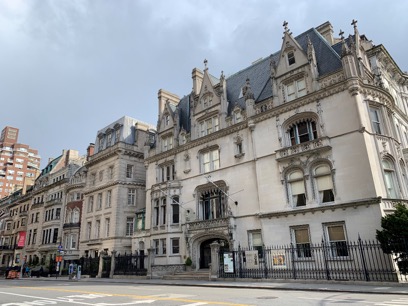
The term “Gilded Age” is used to refer to the period of booming economic growth in the USA in the second half of the 19th century. In New York City this is the period when robber barons like Frick and Carnegie built some of the most extravagant urban palaces the city has ever seen.
Beaux-Arts was the dominant style of architecture in this period, as the greatest American architects from Richard Morris Hunt to Stanford White to C.P.H Gilbert all studied abroad in Paris. These three architects and many others created French châteaux, Italian palazzi, Gothic castles, and Neoclassical mansions in the heart of New York City, and helped give Fifth Avenue along Central Park the cachet it still holds today, as one of the most famous residential neighborhoods in the city.

Tour guides Emma Guest-Consales, Ph.D. , Billy Nemec , Aaron Schielke and Bill Shaffer take turns leading this walk for a stroll up the avenue to gaze at grand residences, to see their exteriors, and to hear stories of their designers and owners.
Don’t miss this experience that takes you back in time to the Gilded Age and up one of the most famous streets in the world.
Tour Highlights
- The Frick Collection once the private residence of Henry Clay Frick, now one of the city’s greatest art museums.
- The James B. Duke House (today NYU Institute of Fine Arts) modeled after a French château, this was the home of Doris Duke, the “richest girl in the world.”
- The Payne Whitney House (today Cultural Services, Embassy of France) where a statue by the teenage Michelangelo was rediscovered in the 1990s.
- The home of Otto Kahn one of the most famous bon vivant of the 1920s who may have been the inspiration for “Mr. Monopoly.”
- Harry F. Sinclair House (now The Ukrainian Institute), an elaborate mansion with most of the original design intact.
- The Cooper-Hewitt National Design Museum Smithsonian Institution , the former home of Andrew Carnegie, who described the 64-room mansion as “modest and plain.”
Book online now!
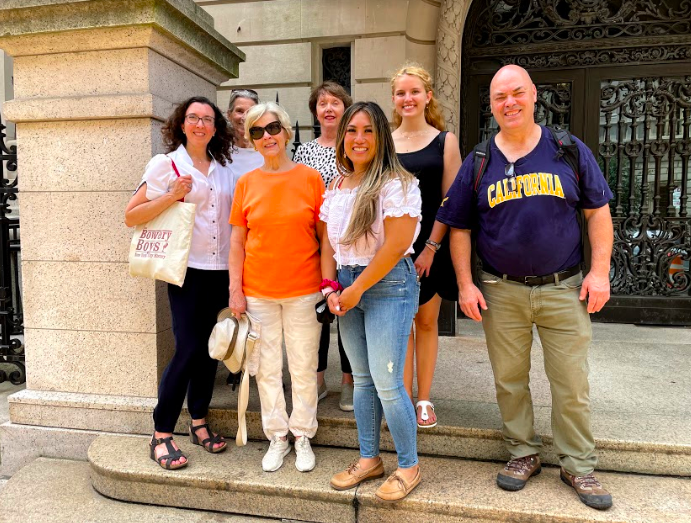
Gilded Age Tour – Thanks, Billy! “Did the Gilded Age Mansions of Fifth Avenue tour with Billy and had a wonderful experience! He was knowledgeable, entertaining, and fun. Even as a New Yorker the Bowery Boys Walking Tours are so interesting – would highly recommend!”
Press: The tour was featured in The Boston Globe in 2022!
Person – Walking Tour: $40.00 (Best suited for adults and most children over 8 years old.)
Private Gilded Age Tours
Let us organize a very special experience for your group or organization to see the Gilded Age mansions of Fifth Avenue. Please contact us to set up a private tour!
Walking Tour: 2 hours
Please note: This tour does not go inside any of the mansions. We will send you the meeting place when you sign up
About one mile of walking
Your guides
Emma Guest-Consales , Ph.D. is an experienced guide, lecturer, and author who has taught art and architectural history in New York City for more than fifteen years. Emma also leads the Ladies’ Mile Cast-Iron Tour and Central Park History and Landscape tour .
Billy Nemec is an experienced tour guide and jazz musician with a deep knowledge of the Gilded Age. He has a certificate of Historic Preservation from New York University.
Aaron Schielke is a licensed New York City tour guide who loves exploring cities. He also leads the Jane Jacobs vs. Robert Moses Bowery Boys Walk .
Bill Shaffer is a licensed New York City tour guide and the author of The Scandalous Hamiltons: A Gilded Age Grifter, a Founding Father’s Disgraced Descendant and a Trial at the Dawn of Tabloid Journalism .
Study up for our walking tour by listening to The Gilded Gentleman episode “The Gilded City: New York 1870 – 1900.”
- Search Please fill out this field.
- Newsletters
- United States
- New York City
- Things To Do
Frick Collection Visitors Guide
Experience art up close in this beautiful Fifth Avenue Mansion
Housed in the Fifth Avenue mansion of Henry Clay Frick, the Frick Collection offers visitors the unique opportunity to view his personal collection within the walls of his former residence. From famous pieces by Renoir and Rembrandt to period furniture and sculptures, a visit to the Frick is a chance at an inside view of the life of wealthy Fifth Avenue residents in New York City.
About The Frick Collection:
The Fifth Avenue Mansion housing the Frick Collection was built in 1913-1914 for Henry Clay Frick, a successful steel and coke industrialist. A longtime patron of the arts, Frick's collection includes a diverse collection of Western painting, sculpture, and decorative arts. What is most impressive about a visit to the Frick is the opportunity to see the art arranged in the mansion. Many pieces are still on display where Frick had originally displayed them.
You can also see the rooms where Frick, his wife Adelaide, and his daughter lived. Their bedrooms were located on the second floor of the building, spaces that are now galleries. Twenty-seven servants lived on the third floor (it's easy to imagine how big this mansion is!)
The building itself is quite spectacular. While it was a private home it was built so it could also serve as a public museum and institution. The original property had two galleries (the Oval Room and East Gallery), a music room, and a garden court. Those all remain today. Decades later a new reception hall, two new galleries, and the portico were added on to the mansion.
What to See: Frick Collection Highlights
The museum is particularly known for its distinguished Old Master paintings. Its permanent collection contains paintings by William Hogarth, Francois Boucher, and Agnolo Bronzino. Note that not all of them are display at any time. If you are interested in seeing a particular painting consult the website , which will tell you if the painting can be seen by the public during your visit.
For those more interested in Impressionist paintings Frick did buy a few works by Édouard Manet , Edgar Degas , and Pierre-August Renoir that are on display.
- The Comtess d'Haussonville , 1845, Jean-Auguste-Dominique Ingres
- The Forge , ca. 1817, Francisco Goya
- Self-Portrait, 1658, Rembrandt
- Mother and Children , ca. 1876-78, Pierre-Auguste Renoir
- Sir Thomas More, 1527, Hans Holbein the Younger
- The Purification of the Temple , ca. 1600, El Greco
- Zephyrus and Flora , 1799, Clodion (Claude Michel)
Special Events
The museum regularly hosts lectures and talks, concerts, and salon evenings. Check the website for the complete schedule . The museum also hosts pay-what-you want drawing and sketching classes for students of all ages.
The first Friday of the month (except in January and September) museum admission is free. In addition to being able to browse the permanent and special exhibitions, you can also hear lectures, see dance and music performances, and try your skills at sketching your own works of art. It's especially fun in the summer when you can venture into the garden.
Things to Know Before Your Visit
The Frick Collection's policy on children (no visitors under 10, and those under 16 must be accompanied by an adult) enables adult visitors to have an intimate experience with the various pieces of art in the collection. Very few items are displayed behind glass, and it is easy to get close to nearly everything in the collection. Displaying the pieces in this way would be impossible if young children were allowed in the museum, as the chance of disaster would be far too high.
The audio tour is included with the cost of admission, and offers a wealth of insight into the paintings, sculpture, furniture and the mansion itself. Using the audio tour to learn more about pieces of interest, a visit to the Frick's permanent collection can take about 2 hours. The Frick also has frequently changing temporary exhibitions .
If you are someone who wants to pack a lot into our visit, consider planning your trip ahead of time with the virtual museum map available on the website. Then you can find the exact pieces of art you are looking for.
Location and Contact Info
- Address: 1 East 70th Street (at 5th Avenue)
- Phone: 212-288-0700
- Subway: 6 to 68th Street
- Official Website: http://www.frick.org/
Related Articles
More related articles.

The Frick Collection in New York: The Complete Guide

Add this and other places to your personal travel plan. We will then help you with further suitable suggestions: free of charge and straightaway!
The Frick Collection art museum is located at the southern end of New York’s famous Museum Mile on the Upper East Side. The villa on Central Park was once the home of Henry Clay Frick (1849-1919), a wealthy industrialist and art collector who, after his death, opened his prestigious residence to the public as a museum.
You'll also love this:
The 36 absolute best museums in new york.
- The 14 Best Art Exhibitions in New York
- The Best Things to Do in the Upper East Side NYC
I’ll tell you everything you need to know about the Frick Collection in New York in this article!
Good to know: The building will remain under renovation until 2023. During this time, you can see many works of art in the nearby Frick Madison (945 Madison Avenue).
Table of Contents
The History of the Frick Collection
The inspiration for the Frick Collection is the collection of the Marquise of Hertford who transformed his residence in London, along with his art collection, into a museum and opened it to the public as the Wallace Collection. Henry Clay Frick looked at this collection in London and became inspired to replicate this idea by turning his estate into a museum after his death. In 1905, the art collector moved to New York to spend his retirement years. Architects Carrère and Hastings were commissioned to build a villa in New York’s Central Park .
At the corner of Fifth Avenue and 70th Street, a luxurious villa was built for Henry Clay Frick and his wife Adelaide in 1913/1914 at a cost of $5,000,000. When Frick died in 1919, the residence went into a trust in accordance with his wishes. However, his wife continued to live in the villa.
It was not until after her death in 1931 that some renovations began to prepare the building for museum use. Additional exhibition rooms, an atrium, and a concert hall were added. In 1935, the Frick Collection finally opened as Frick had wished in his lifetime. To ensure the upkeep of the collection, Frick had left an additional $15,000,000. This money also allowed for additional purchases of artworks for the collection, which was also Frick’s wish.
The Frick Collection Artworks and Exhibitions

In addition to the 131 paintings acquired by Frick, 75 more paintings were added over time, which were purchased by the foundation. In 1977, the Frick Collection received two additional exhibition rooms for temporary exhibitions and now displays more than 1,100 works of art in 16 impressive gallery spaces.
The collection consists primarily of works spanning from the Renaissance through the late 19th century. The 131 works in Frick’s original collection are not allowed to leave the museum at his request. There are regular temporary exhibitions and classical concerts held in Frick’s former estate.
In 2001, an exhibition of impressive sculptures and porcelains was added, for which part of the building was glazed.
A Role Model for Many Other Art Collectors
The Frick Collection is a model for many art collectors in the United States. Inspired by Frick, many art collectors are now thinking about what would happen to their collection after death and considering donating it to a museum. The Kimbell Art Museum in Fort Worth, Texas, is considered the largest example. However, Andrew Mellon also donated his art collection and used it to finance the construction of the National Art Gallery in Washington, D.C.
The Frick Collection Café
A beautiful ambience awaits you at the Frick Collection Café, also called “Museum Café.” It offers both indoor and outdoor seating.
Shopping in the Villa
Of course, there is also a museum gift shop in the Frick Collection. Poster prints of the artworks, fun mementos of the Frick Collection, bags, watches, or just a postcard for art-loving friends? Everything is very beautifully presented and really fun to look at, making picking out a souvenir from this unique museum an activity to look forward to.
Tickets for the Frick Collection in New York
You can buy tickets directly at the museum or on the official website .
How much time should I plan for a visit?
The visit to the museum starts with a 12-minute film about Henry Clay Frick’s life, his collection, and his intention to preserve his mansion. In total, you will not need more than 3 hours to see everything at the Frick Collection.
Is the Frick Collection suitable for children?
Due to the fact that the museum is located in Frick’s former private quarters, the furniture and carpets from his time have been preserved in the rooms. As a result, children under the age of 10 are not allowed in the museum. Children under the age of 16 may enter the museum but only under the supervision of a parent or guardian.
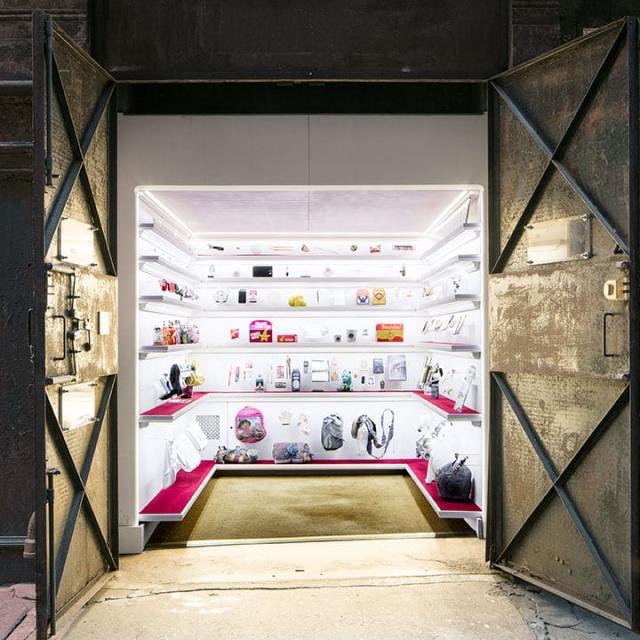
The 28 Best Art Exhibitions in NYC to Check Out

29 Amazing Things To Do in the Upper East Side

I'm a true New York fan! Not only have I visited the city over 25 times but also have I spent several months here at a time. On my blog I show you the best and most beautiful spots of the city, so that you have a really good time! You can also find lots of insider tips in our New York travel guide . Also check out my hotel finder for New York !

Hole dir deine wöchentliche Dosis New York mit meinem Loving New York-Newsletter! Er ist vollgestopft mit den neuesten Artikeln, Videos, Erfahrungsberichten und allem, was gerade Interessantes und Wissenswertes im Big Apple passiert.
Ich selbst war über 25x in meiner Lieblingsstadt und möchte dir mit meinen Emails dabei helfen, eine sensationelle Zeit vor Ort zu haben.
Und als BONUS bekommst meine ✔️ "24 Tipps für deine New York-Reise" ✔️ die U-Bahn-Karte und ✔️ die offizielle NYC-Karte zugeschickt. Ganz KOSTENLOS!
Start of your trip: We will remind you with current events when you are in NYC!
🙌 Awesome, you're subscribed!
Thanks for subscribing! Look out for your first newsletter in your inbox soon!
Get us in your inbox
Sign up to our newsletter for the latest and greatest from your city and beyond
By entering your email address you agree to our Terms of Use and Privacy Policy and consent to receive emails from Time Out about news, events, offers and partner promotions.
Awesome, you're subscribed!
The best of New York for free.
Sign up for our email to enjoy New York without spending a thing (as well as some options when you’re feeling flush).
Déjà vu! We already have this email. Try another?
- Things to Do
- Food & Drink
- Time Out Market
- Coca-Cola Foodmarks
- Attractions
- Los Angeles
Your guide to the NYC's newest museum, the Frick Madison
The new temporary space offers a completely different experience.

The Frick Collection is starting a new chapter after 85 gorgeous years at its 1 East 70th Street mansion.
Starting March 15, The Frick Madison will be open at 945 Madison Avenue—the former home of the Whitney Museum of American Art and the Met Breuer—while Henry Clay Frick's mansion undergoes a massive renovation. This new stint will last two years, and while the Brutalist building by Marcel Breuer is a huge departure from the Gilded Age mansion, the space is offering a much different and rare look at the collection, according to museum officials.
Unlike at the Frick Mansion, the Breuer building is a clean slate—stark in contrast, which actually helps to attract the viewer's attention to individual works. Eyes aren't busy looking at ornate furniture here. It's all about seeing the smaller details in the artwork that you might have overlooked at the mansion. According to Anna-Maria and Stephen Kellen Director Ian Wardropper, "It's a different Frick than you’ve ever known."
So before you jump on the train to check out the museum's new digs, here's what you'll need to know.
You don't want to miss certain moments in the Frick Madison. While the Frick Collection as a whole is certainly impressive, there are new ways to experience them at Frick Madison that weren't there before. We scouted out the museum on Thursday so you know exactly what to keep an eye on when you go.
Firstly, download the Bloomberg Connects app on your phone. Most of the artwork at Frick Madison does not have descriptions on the wall alongside them. For that, we recommend the app, which has both text descriptions and short two- to three-minute audio clips by the curators, Xavier F. Salomon and Aimee Ng.
Don't miss these rooms:
Second floor
Vermeer (Room 6)

If you love Girl with a Pearl Earring, you'll want to feast your eyes on this room reserved for Vermeer paintings only. There's plenty of space to spend time with Mistress and Maid (the last work that Frick acquired before he died in 1919) and Officer and Laughing Girl.
"On rare occasions, we've shown them together before, but never like this, where you're surrounded on three sides by Vermeer," Ng said on Thursday. "You almost encounter them anew...without the furnishings and chairs installed in front of paintings, in this simple architecture of the building, you feel like you're meeting them for the first time. Their subtle details and images suddenly emerge."
Van Dyck (Room 5)
Missing the Van Dyck room is impossible because his portraits, for the most part, are absolutely gigantic. Frick himself had more works by this artist than any other European painter. And for the first time, you can see these eight works—spanning all periods of his life—together in one room.
Third floor
Bellini’s St. Francis (Room 13)

You'll want to spend some time with Bellini's St. Francis in the Desert. Painted in the late 1740s, it shows the saint with arms wide open with the sunlight shining down on him from the upper left-hand corner of the painting. It's one of the Frick's most beloved paintings, and it has been placed in its very own room with a window.
"Here, [the painting] seems to be enjoying his moment of solitude," said Ng. "The painting is about faith, nature and human kind's place in nature, and above all, it's about light. We put this painting in conversation with the Breuer's trapezoidal window." Doing so mirrors the painting's source of light with actual light from the outdoors to create a "chapel-like" experience.
Female Venetian artist (Room 12)
Not many female painters were celebrated in the 18th century, but one of them, Rosalba Carriera, was renowned for her portraits. You can see two of them in this small room off to the side of the main Italian room.
Enamels and Clocks (Room 16)
You will want to spend more time looking at the intricate details on these incredible enamels and clocks produced between 1540 and 1640. Many of the enamels came from the collection of John Pierpont Morgan (the same one behind the Morgan Library & Museum) and were used and displayed as tableware. Across the way in the same room, gaze at the inner workings of clocks and watches that date to the 16th and 17th centuries.
Fourth floor
Fragonard (Room 24 and 25)

Frick Madison has a lot of ornate French artwork, but Fragonard's monumental canvases are absolutely stunning. His Progress of Love artworks for the mistress of King Louis XV (Madame du Barry), were made for her home but she (shockingly) rejected them. In the next room, you'll see a handful of more canvases that complement the Progress of Love paintings. These tall canvases decorated the artist's cousin's home outside of Paris. This is the first time both "campaigns" of Progress of Love have been shown together at the Frick.
Marie Antoinette furniture (Room 19)
The Frick Collection's wildly decorative furniture gets its own spotlight here, and most interestingly, are two pieces that Marie-Antoinette actually owned. Jean-Henri Riesener crafted a matching commode and secretaire for her the year she ascended to the throne with King Louis XVI. They're so ornate, with gilt bronze, leather, marble and wood, that it's easy to imagine just how luxurious their palace was. Above them, porcelain pieces are showcased.
Whistler (Room 22)
Frick Collection features one American-born artist, Whistler, in his own room. If you don't know, Whistler created portraits of London's social elites. His gorgeous paintings were inspired by Japanese prints, which is reflected in his use of a butterfly monogram he used to sign his works.
Those who love impressionism can find their favorites in the last room—Degas, Manet, Monet, Renoir and Corot.
Ticketing information
Starting March 18, 2021, Frick Madison will be open four days a week, Thursday through Sunday, from 10am to 6pm. Capacity is capped at 25 percent, so general admission tickets have to be purchased online in advance. (Free admission to the reading room is also timed and by appointment.) Don't forget your mask and make sure to stay at least six feet from others. Grab your ticket at frick.org/tickets . Adult tickets are $22.
Most popular on Time Out
- These NYC movie theaters are opening on Friday—here’s what you can expect - This under-the-radar NYC movie theater was named one of the three most beautiful in the world - A giant outdoor performing arts center is opening at Lincoln Center this April - Javits Center and Yankee Stadium will be administering vaccines 24/7 starting this week - The best things to do in NYC this weekend
Want to know what’s cool in the city? Sign up to our newsletter for the latest and greatest from NYC and beyond.
Been there, done that? Think again, my friend.
Popular on Time Out
Discover Time Out original video
- Press office
- Investor relations
- Work for Time Out
- Editorial guidelines
- Privacy notice
- Do not sell my information
- Cookie policy
- Accessibility statement
- Terms of use
- Copyright agent
- Modern slavery statement
- Manage cookies
- Claim your listing
- Local Marketing Solutions
- Advertising
Time Out products
- Time Out Worldwide

Guide To NYC’s Frick Collection: What To See + Tips
In the heart of New York City’s Upper East Side lies the Frick Collection — an exceptional fusion of art, history, and luxury.
The Frick Collection boasts a splendid array of art and artifacts that span centuries and genres. Visitors can admire an impressive collection of European paintings by renowned artists like Rembrandt, Bellini, Holbein, Vermeer, and Goya.
In addition, the museum houses exquisite decorative arts, including porcelain, sculptures, and antique furniture.
For years, this was all set within the opulent former residence of industrialist Henry Clay Frick. But when Frick’s mansion needed major renovations, the collection moved to the Breuer Building. For now, it’s referred to as Frick Madison.
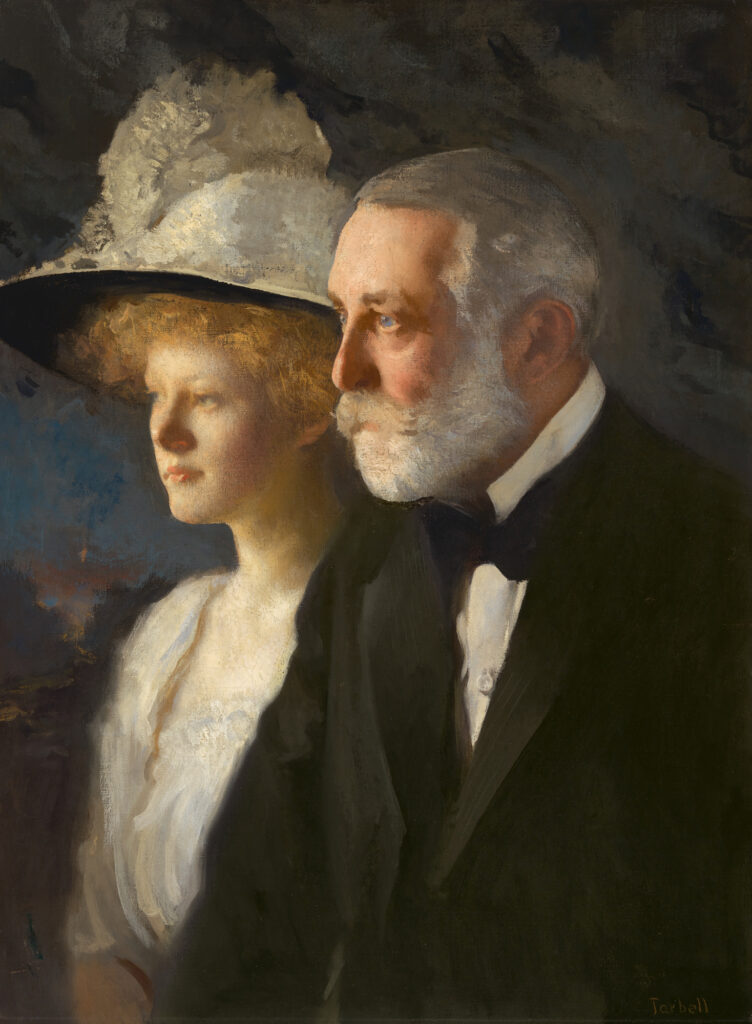
In this Frick guide, you’ll learn about the museum’s history and recent renovations, the must-see masterpieces of the collection, and get essential tips for visiting.
History of the Frick Collection
Here’s a quick history before we dive into what to see.
Henry Frick
Henry Clay Frick grew up working class. But nothing stopped him. He was ambitious.
By 30, Frick was a prominent figure in Pittsburgh’s industrial landscape. Frick distinguished himself as a captain of industry, a generous philanthropist, and a passionate patron of the arts.
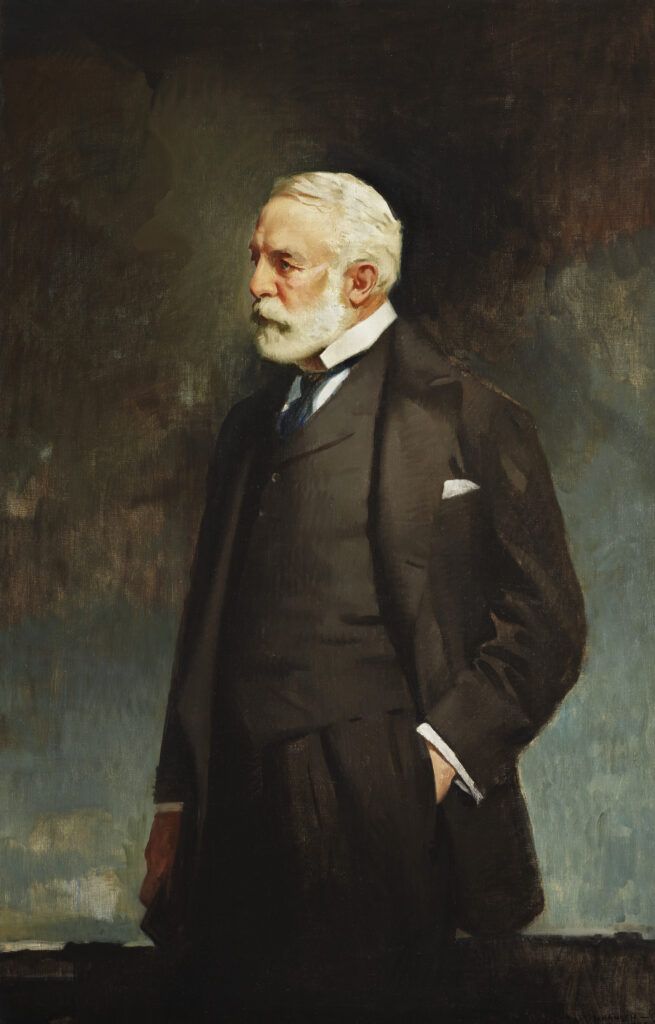
Following his partnership with Andrew Carnegie, Frick emerged as one of the most affluent magnates during the era of the “robber barons” in the United States. He lived in the luxurious Clayton House, which you can still visit today.
After breaking with Carnegie, he decamped from Pittsburgh to New York City in 1901. He built himself a classically-inspired Beaux Arts mansion the width of a city block.
The firm of Carrère & Hastings designed the 1914 structure. Frick went to town decorating its opulently appointed rooms, encasing them in marble, gold brocade, and mahogany. He amassed an amazing old masters art collection.
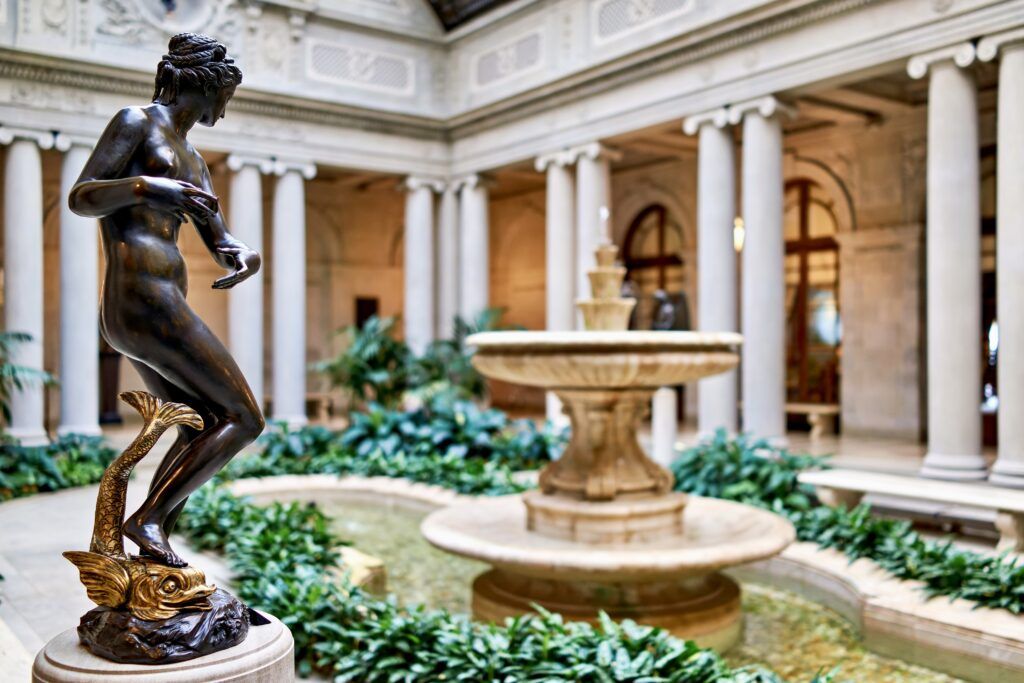
The Frick Collection
Frick’s interest in art grew over the years. He began collecting Old Master paintings. His first purchase was in 1881.
Following the fashionable taste of the era, Frick purchased primarily European paintings from the Renaissance through the late 19th century. He had a decided appreciation for works by Rembrandt, Vermeer, Holbein, Goya, and Titian.
Later in life, he expanded into European decorative arts, enamels, Renaissance bronze sculpture, and Chinese and European porcelain. Collecting, Frick said, gave him “more real pleasure than almost anything.”
Frick passed away in 1919, but left money for future acquisitions. He left the museum to the public, saying it was “a public gallery to which the entire public shall forever have access.”
His wife died in 1931. After that, their mansion underwent a transition and galleries were added.
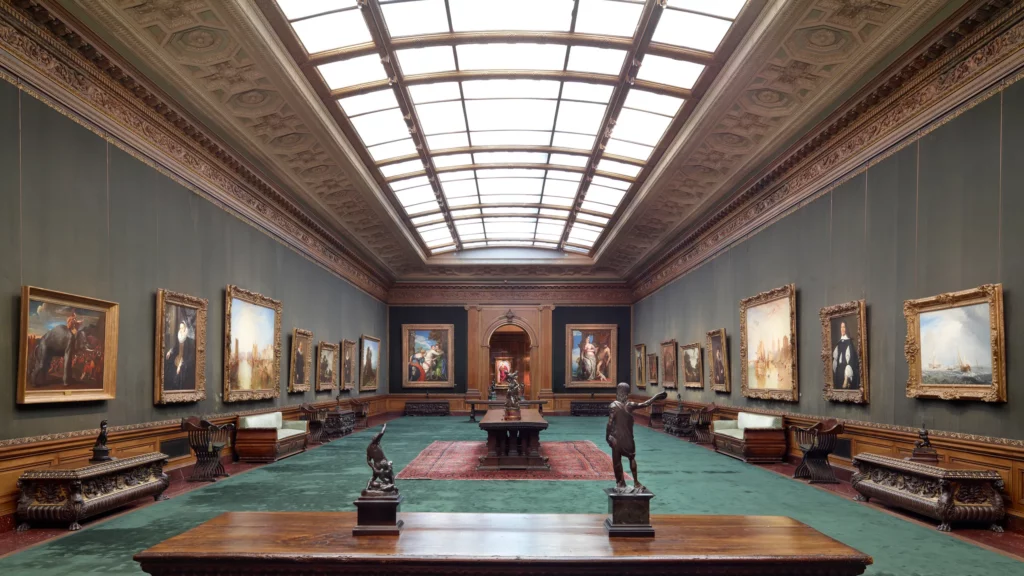
In 1935, the collection opened as a museum. Over 130 paintings are set amid exceptional sculptures, decorative arts, and period furniture. There are no labels. You can do your own curating.
Frick’s mansion itself is a work of art, designed by renowned architect Thomas Hastings. It provides a fitting domestic backdrop for the extremely high quality of the masterpieces within.
Unlike other similar museums, the Barnes Foundation for example, the collections is not frozen in time. New acquisitions are still being added.
Frick’s daughter Helen beefed up the collection with some early Renaissance paintings and the famous Ingres portrait. Most recently, the museum was bequeathed 26 works on paper by major artists such as John Singer Sargent, Francisco de Goya, and Elizabeth Vigée Le Brun.
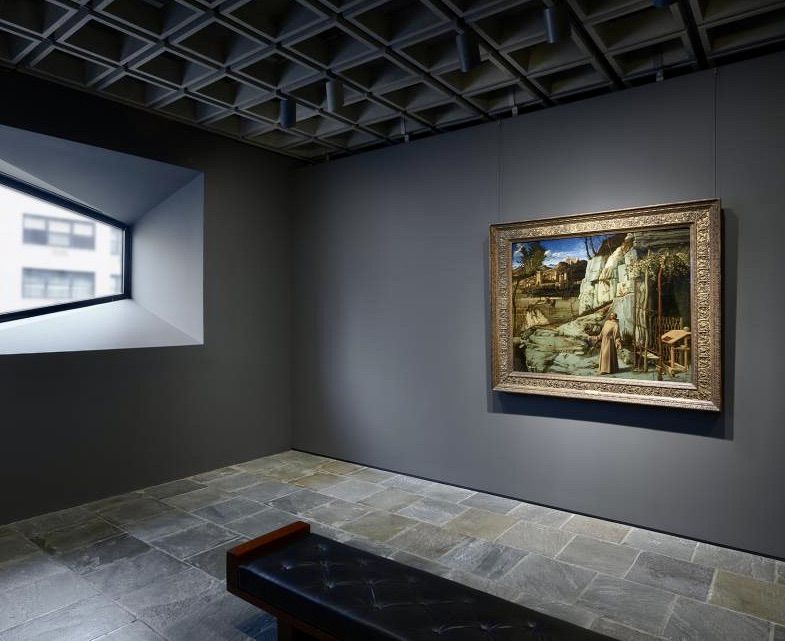
The Frick’s Temporary Move
But the Frick Collection grew too large for its space. More room was needed to display a growing collection, host special exhibitions, and add areas for conservation work and education.
Most changes will be surgical, repurposing space, rather than additive. The garden designed by Russell Page, one of the foremost garden designers of the 20th century, will also be restored.
To kick off the renovations, in March 2012, The Frick Collection moved into the Marcel Breuer–designed building at 945 Madison Avenue.
The building once held housed the Whitney Museum of American Art and then a selection of the Metropolitan Museum of Art’s modern and contemporary collection.
It’s known as Frick Madison. The museum will return to its elegant Gilded Age home on Fifth Avenue at 70 Street, hopefully, by the end of 2024.

Museum or Mansion?
Museum or mansion, which is a better museum experience? If you’ve visited both places, you probably have a preference. Or perhaps you enjoyed both venues.
I personally adore the setting of private art collection curated by the owner in his or her own mansion. It’s an intimate experience that’s a stark contrast to the white walls of a museum. You feel like an old family friend.
So, I love small museums like the Isabella Stewart Gardner Museum , The Barnes Foundation , and the Wallace Collection in London.
But I must admit … I really enjoyed seeing Frick’s works at the Breuer reframed in such an unprecedented way. Just for a change of pace.
You could see the artworks better is serene isolation, without any distraction from the sumptuous mansion setting. It’s just you and the masters in empty rooms with no labels. And, for the type A among us, it was nice seeing them organized by chronology, geography, and art movement too.
Enjoy it for the next year+. This is the only time all the works have been outside the confines of their Frick stomping grounds.

Guide To The Frick Collection: What To See
Here are some of the top masterpieces and artworks you can’t miss at the Frick Collection.
1. Duccio, The Temptation of Christ on the Mountain
The Sienese artist Duccio is recognized as a pioneer in the early development of Western art. Although his artworks contained traditional Byzantine elements, he imbued his creations with a sense of lyricism and authentic human emotions.
His figures radiate a distinctive tenderness, offering a glimpse into the artistic trends that would later come to define the High Renaissance. His Maesta in Siena Cathedral is the high point of early Renaissance painting.
In this work, Christ rejects the devil and his offer of material goods. The two central protagonists dominate the space.
Christ’s elegant pose and his simple gesture contrast with the dark monolith that is the devil. It has the flowing colors and beautiful design typical of early Renaissance achievement.

2. Piero della Francesca, St. John The Evangelist
Piero della Francesca is widely regarded as a genius and a foundational artist of the early Renaissance period, known as the Quattrocento. During his lifetime, he was held in the highest esteem, like a monarch among artists.
Piero’s works are highly linear and calculated, characterized by an infused calm and geometric sobriety. His cool tones and unmoving figures created a dream-like sense of timeless stillness.
St. John was the first major painting purchased by the Frick after it opened as a museum. The museum has three other Piero works as well.
It’s a large panel painting that typifies the artist’s style. The saint stands barefoot, in a red cape, on a marble floor. With his customary care, Piero delineated John’s weathered features, twin pointed white beard, and strong hands (which are lightly illuminated).
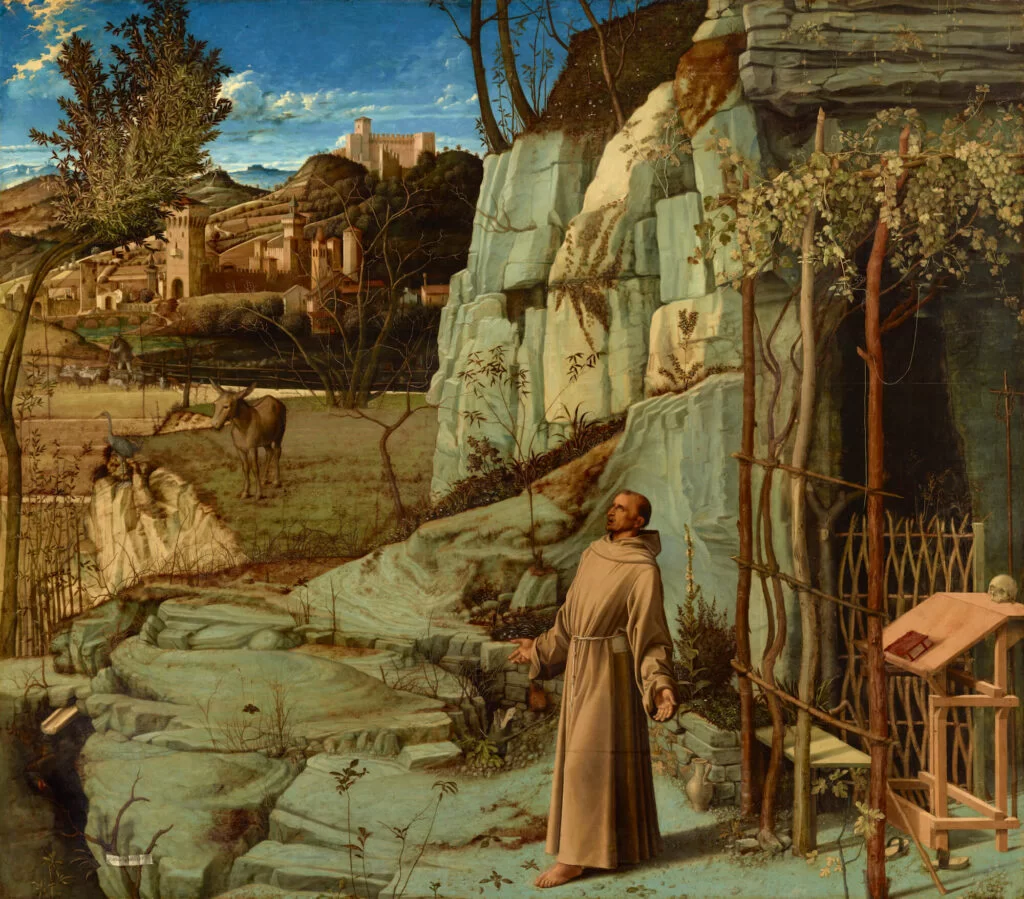
3. Giovanni Bellini, St. Francis in the Desert
This is perhaps the best painting in the Frick Collection. The majestic Bellini has its own room at Frick Madison.
Many art historians consider Bellini’s work the most beautiful painting in the United States. It’s certainly one of the most famous Renaissance masterpieces in the US .
St. Francis of Assisi is show in a contemplative rocky rural tableau, which imparts a sense of mysticism. It might be situated in the place Francis received his stigmata. And, with outstretched arms, Francis certainly seems like he’s going through some things in the painting.
Bellini’s exceptional artistry shines through as he expertly renders light, texture, and the beauty of the natural world. Its meticulous details, balanced composition, and the emotional depth are hallmarks of Bellinin’s art.
The wildlife (a little bunny, a donkey, and a heron) symbolize Francis’ unwavering devotion to the environment and all living creatures.
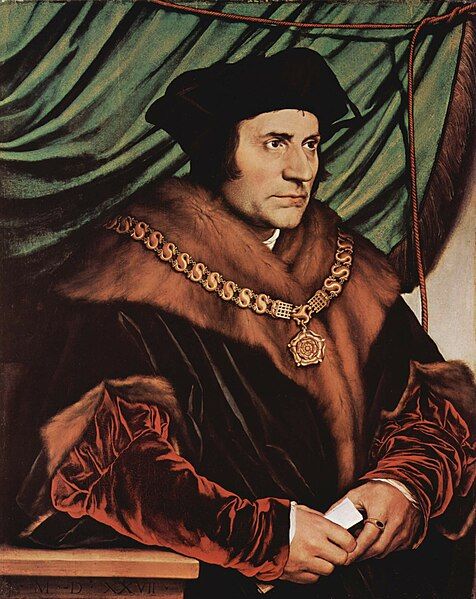
4. Hans Holbein, Sir Thomas Moore
Holbein’s two famous paintings of the “Wolf Hall rivals” depict Thomas Moore and Thomas Cromwell.
They usually sit on either side of the Frick’s fireplace. Holbein was popular at the court of Henry VIII. Sir Thomas Moore is one of his most riveting portraits.
Moore’s portrait is a miracle of elegance and empathy, one of Frick’s portraits of principled men. Moore stares fixedly to the right. The chain of office with the Tudor rose pendant marks him as a man in command.
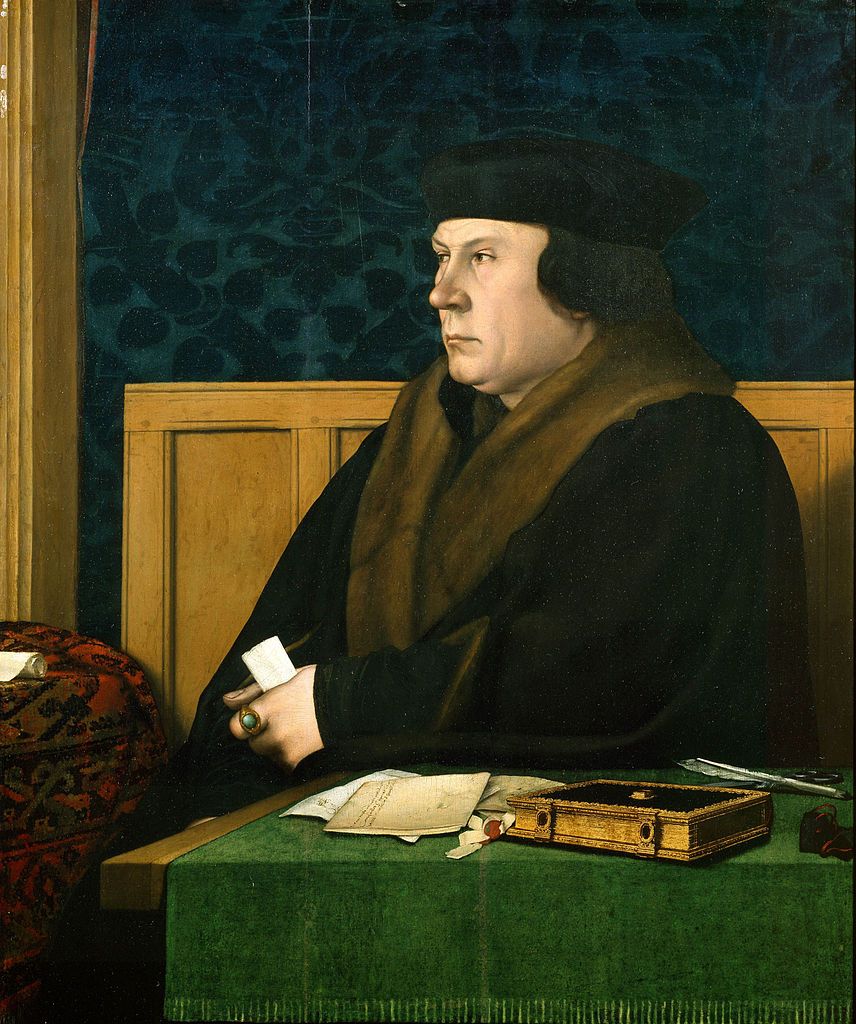
5. Hans Holbein, Thomas Cromwell
Across from Moore is his nemesis Cromwell.
He is, of course, the minister who interrogated Moore and ordered his execution, when he wouldn’t go along with Henry’s desire to get a divorce or annulment. In a parable of the vagaries of power, Cromwell too was executed by Henry.
In this portrait, Cromwell looks more like a churlish thug, with a severe expression, than a leader. But the portrait is rich in color.
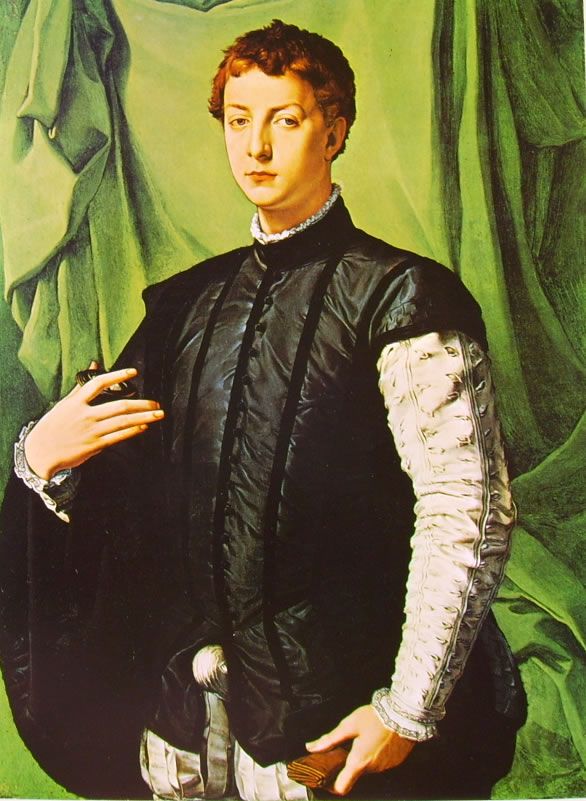
6. Agnolo Bronzino, Ludovico Capponi
Bronzino was a Mannerist painter in the Renaissance court of Cosimo I in Florence. His works are characterized by their meticulous attention to detail, refined compositions, and an elegant (sometimes enigmatic) portrayal of his subjects.
This is an immaculate portrait of a handsome, arrogant, somehow discontented youth. Though his haughty stare still reveals a hint of vulnerability.
The youth is clad in a gorgeous outfit that features a startlingly projecting codpiece. The black and white outfit contrasts with the green drapery in the background.
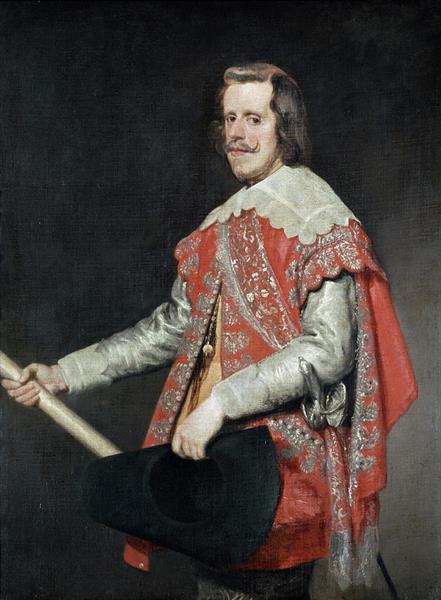
7. Diego Velazquez, King Philip IV of Spain
Diego Velázquez was a Spanish Baroque painter. He was a “painter’s painter,” renowned for his masterful use of light and shadow and his ability to capture the essence of his subjects with remarkable realism.
The artists was also the official court painter of the king. This 3/4 length portrait has the king’s usual glum countenance and slightly sagging jowls.
The king is posing in the silver and rose costume after having just won a battle against the French. Velazquez actually had to paint it quickly under makeshift circumstances.
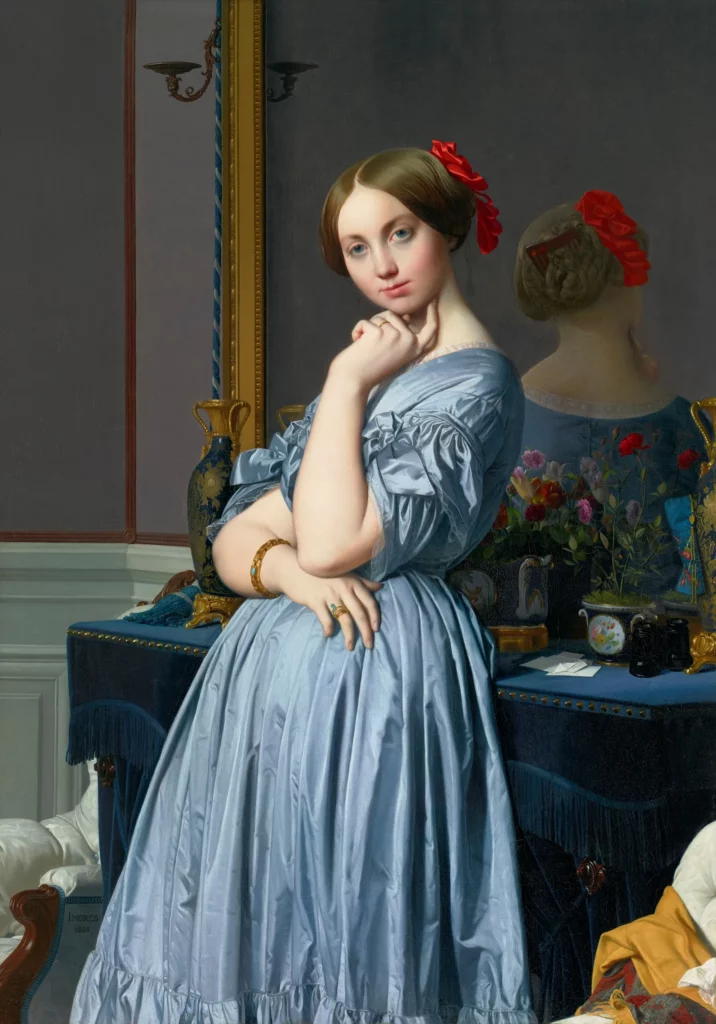
8. Jean-Auguste-Dominique Ingres, Comtesse d’Haussonville
You can’t help but fall in love with this painting. Ingres was one of the greatest portrait painters in France.
The young princess in blue satin is Louise-Albertine, rendered with Ingres’ famously precise line and impossible beauty. Not a brushstroke is out of place.
She stars out at the viewer with a penetrating gaze, raising her finger to a pulse point on her throat.
Her chignon, adorned by a scarlet ribbon, is reflected in a large mirror installed behind her. Accoutrements of wealth and culture—including gilt-bronze porcelains, opera glasses, and scattered calling cards—abound.
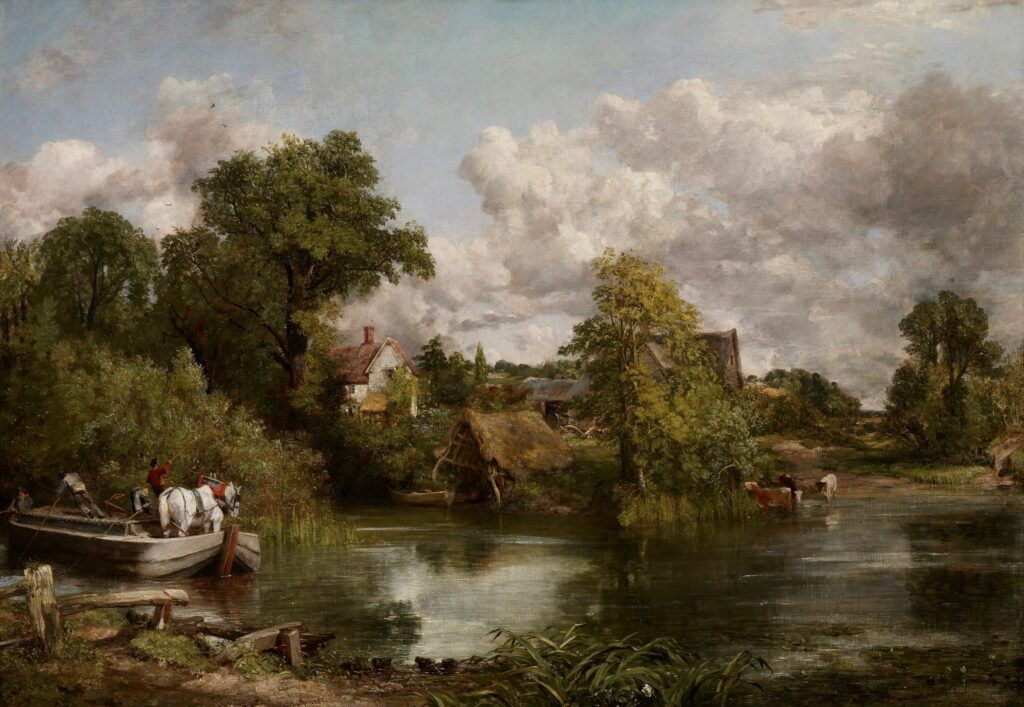
9. John Constable, The White Horse
John Constable was a prominent English landscape painter of the 19th century.
He’s celebrated for his masterful ability to capture the natural beauty and atmospheric nuances of the English countryside. He was one of the first artists to work en plain air .
The White Horse is a serene scene, with a close observation of nature. Constable made many studies for the scene. It was one of his favorite works and he kept it until his death.
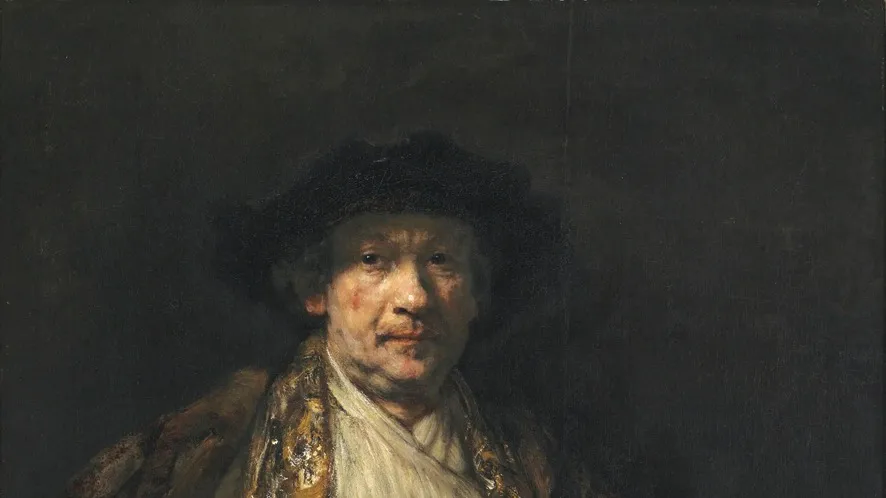

10. Rembrant, Self-Portrait
Frick and his Gilded Age peers loved Rembrandt. The artist’s works have an inherent look of luxe.
This very self aware self-portrait was painted in 1658, and is definitely one of the best pieces in the museum. At the time, Rembrandt was sorely beset by personal and professional woes, and it shows in his face.
The artist was 52 when he painted this monumental image. A year earlier, he’d been forced to hawk his art collection. Soon he would lose his home.
But he kept painting, just to bring in some guilders. With that in mind, he portrayed himself in an attention-grabbing style he’d been developing and pushed it hard: rugged brushwork, chunky surfaces, tonal contrasts that could be read from across a room.
Still, despite being near financial ruin, this is Rembrandt at his best. Thick impasto gives his robe a palpable presence. His powerful hands and penetrating eyes, staring right at you, leave an indelible image on your mind.
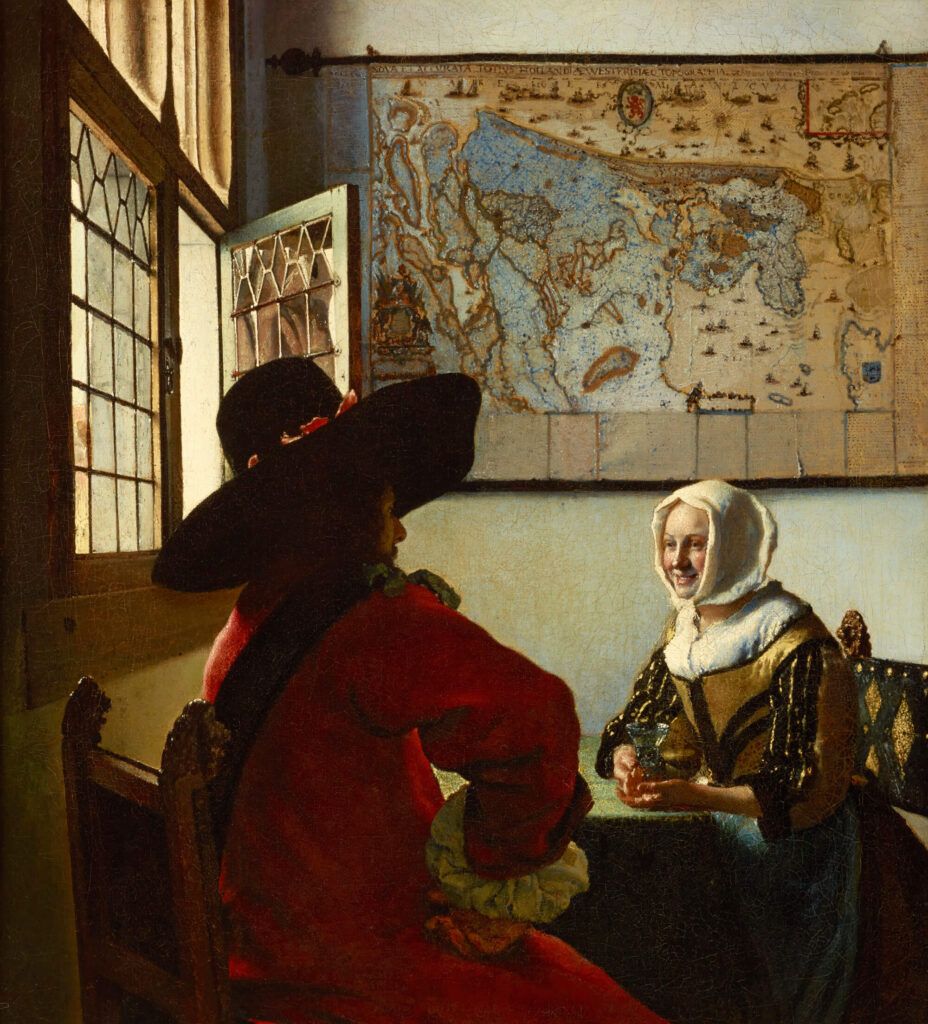
11. Vermeer, Officer and a Laughing Girl
This is the best of three Vermeer paintings in the Frick Collection. The genius in the master of the Dutch Golden Age lies in his depiction of light.
In this painting, daylight streams in through an open window at the left. It illuminates the back wall and the smiling face of the girl.
Across from her is a swaggering officer. You can’t see his features.
Vermeer’s paintings frequently have a subtext of love. And the officer may be flirting with the girl.
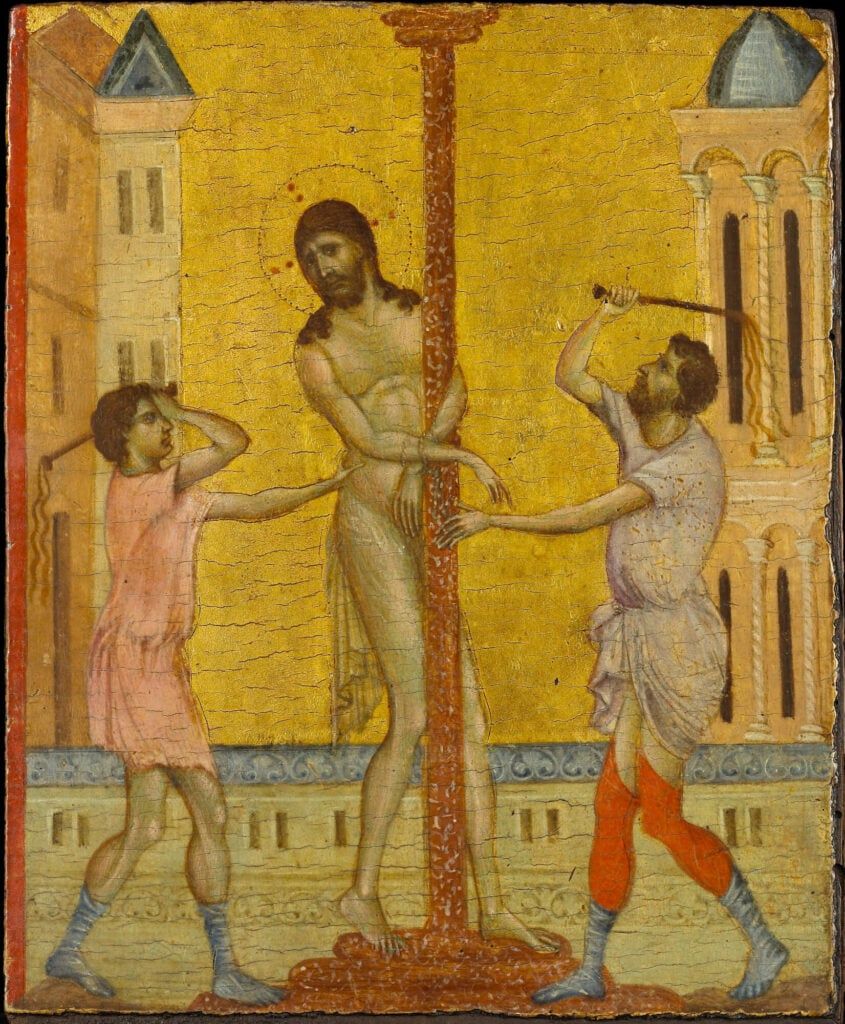
12. Cimabue, The Flagellation of Christ
Cimabue was a great painter and key figure of the 13th century. Like Giotto, he helped move painting from the static Italo-Byzantine style into the more naturalistic Renaissance style.
This is the one and only work by Cimabue in a public collection in the US. And very few of his works survive today. There are some in the Basilica of Santa Croce in Florence, in Arezzo , and in the Basilica of St. Francis in Assisi .
The Frick acquired the Flagellation in 1950. The small devotional panel has a gold ground, typical of medieval paintings in Italy. It shows the flagellation, a key moment in the passion of Christ.
But you can also see that Cimabue is beginning to break the boundaries. There is a suggestion of spatial perspective. Christ is rather elegantly attached to the porphyry column.
Because the panel was so small and his other works so large, there was a debate about authenticiity. Some art historians thought it was a Duccio. But when another Cimabue painting was discovered, it was clear that the Flagellation was part of a larger work, probably a dyptich.
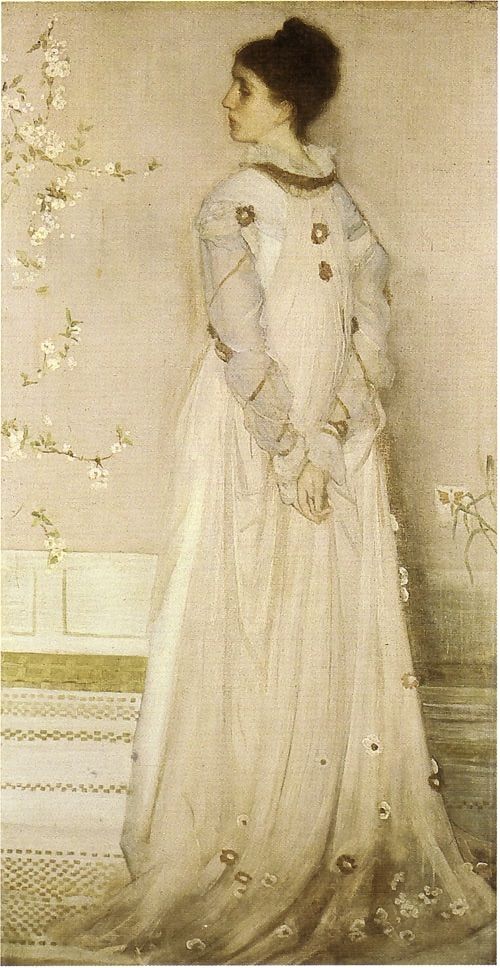
13. James Whistler, Symphony in Flesh Color and Pink
James McNeill Whistler was an American-born painter active during the 19th century.
He’s renowned for his innovative approach to art, particularly in the realm of tonal harmony and capturing the ethereal qualities of landscapes and cityscapes.
This portrait of Mrs. Frances Leyland is from 1871-74. You can see his complete commitment to pure line and form. His title describes an abstraction of color akin to music.
The flowing dress is framed by almond blossoms of the same color. After this portrait, Whistler created the famous Peacock Room, which is not in the Smithsonian Museum of Asian Art .
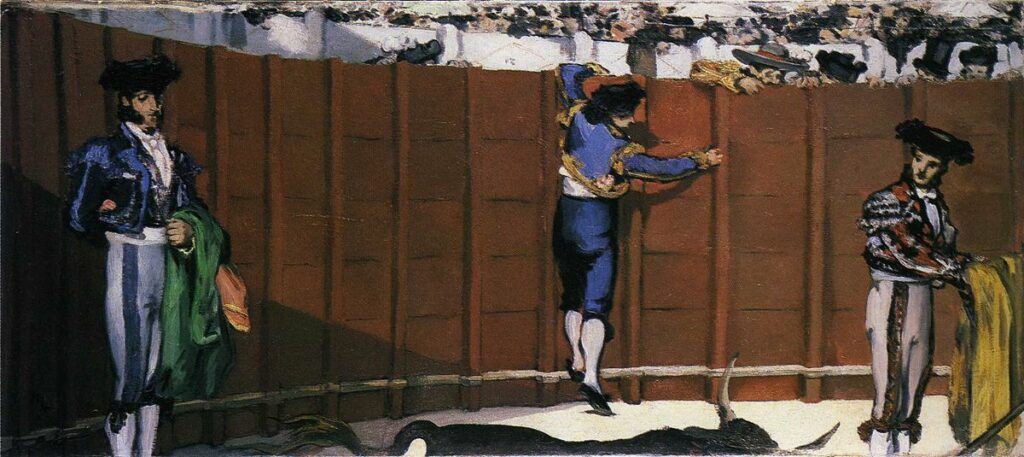
14. Edouard Manet, The Bullfight
Frick mostly collected old masters. But he also bought some French Impressionist paintings from around the turn of the century.
My favorite is the is excellent Edouard Manet painting, The Bullfight . Three brilliantly costumed bullfighters occupy the curved corner of a ring. They are created with abstract patches of color and form, very progressive for the 1860s.
Salon critics ravaged the painting. Manet took it home and cut it in half, reworking both pieces. Its fragmentary style and odd angle gives the painting an immediacy.
The Frick owns the top half. The other half is in the National Gallery of Art In London .
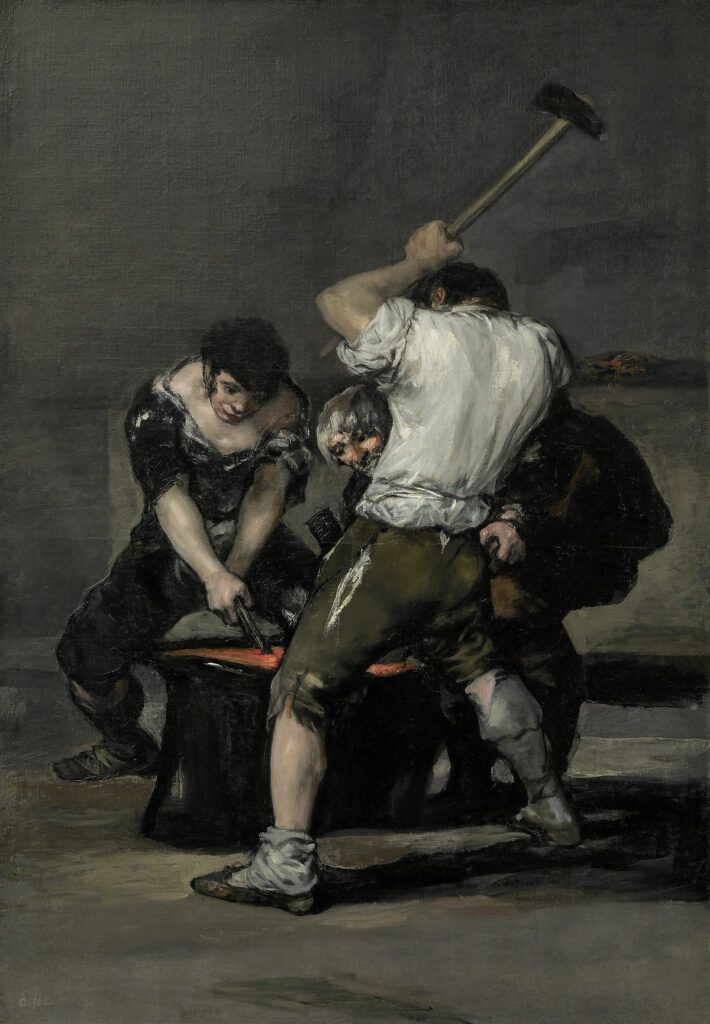
15. Francisco de Goya, The Forge
Francisco Goya was a Spanish Romantic painter celebrated for his unflinching portrayal of the human condition. Though he was a court painter, he seemed to prefer depicting the common man.
In this work three men huddle around an anvil. Their poses and expressions are intense. The black-gray-white color scheme draws you attention to the red patch int he center.
Some art historians think the painting represents the forge of Vulcan, the Roman god of fire, from mythology. But there’s not evidence for that.
The roughly executed image was painted at the end of Goya’s career, right before the Black Paintings in the Prado Museum .
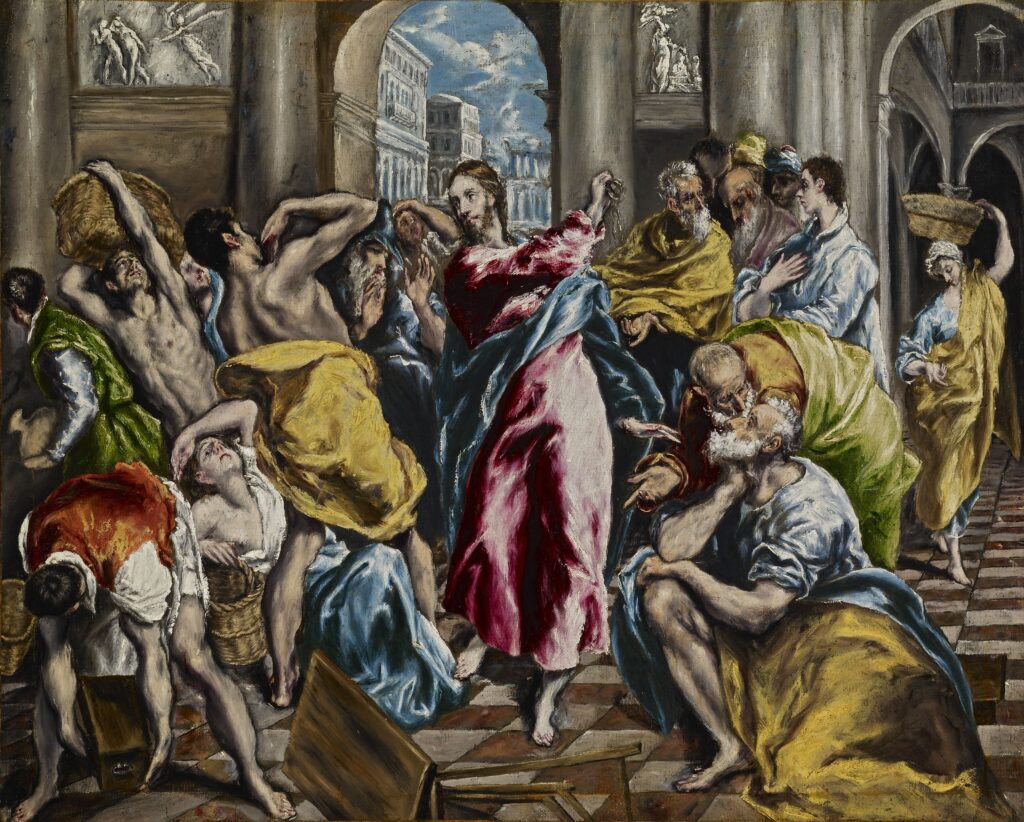
16. El Greco, The Purification of the Temple
The Purification of the Temple is a significant work by El Greco, a Spanish Mannerist painter known for his expressive and spiritual style.
The painting depicts the intense biblical scene with Jesus cleansing the Temple. The artists used elongated figures and vibrant colors to convey the emotional and religious intensity of the moment.
Frick considered El Greco to be modern. In the collection’s old digs, it was hung with Manet and Degas paintings. Another El Greco, St. Jerome , sat above the fireplace next to Moore and Crowell.
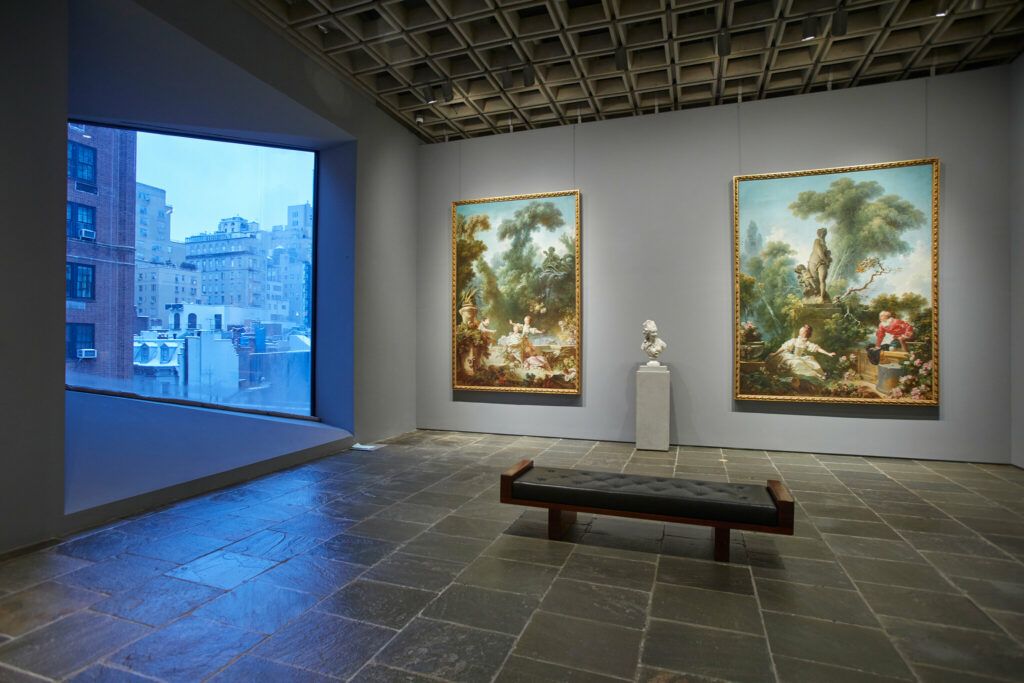
17. Fragonard Room
The Fragonard Room is named after Jean-Honoré Fragonard, one of the most celebrated painters of the Rococo era. Frick bought the paintings from fellow financier J.P. Morgan in 1898.
This room has four large canvases from The Progress of Love series. They depict scenes of courtship and love in a garden setting.
It’s a theatricalize stage of euphoric adolescent love, sometimes described as a “French love bomb.” Its Rococo showiness departs from the Frick’s generally sober temperament.
The colors are gorgeous, the landscapes and profusion of flowers are lush. Love Letters is the last of the four canvases. In it, an adoring couple read their love letters, remembering the course of their affair.
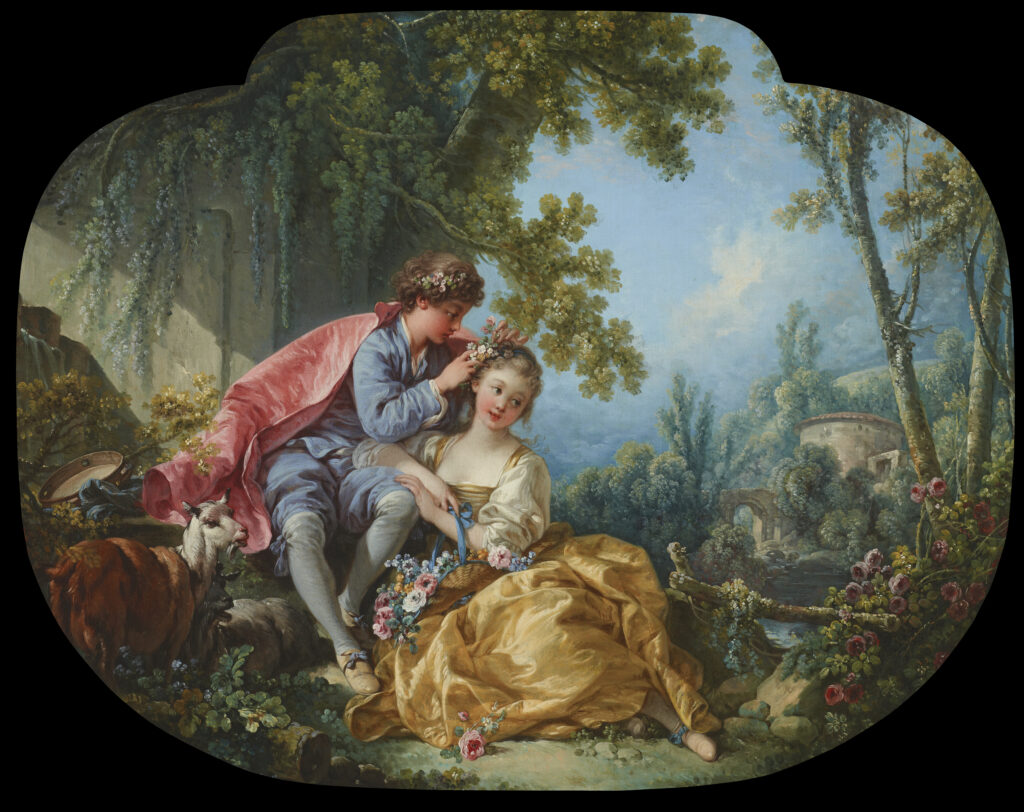
18. Francois Boucher, The Boucher Bedroom
The Arts and Sciences is a delightful series of eight panels created by the Rococo artist Francois Boucher. He’s celebrated for his mastery of decorative and playful art, which often featured luxurious and romantic themes.
In each panel, you can see the embodiment of a pair of arts and sciences, Charming young boys and girls flirt and possible hook up.
The realm of arts encompasses painting, sculpture, singing, dancing, poetry, music, comedy, and tragedy. The sciences delve into architecture, fowling, horticulture, chemistry, fishing, hunting, astronomy, and hydraulics.
These scenes, with their charming and slightly whimsical nature, evoke a sense of modern-day cartoons. Yet, beneath their surface lies a depth that becomes apparent upon closer inspection.
It’s possible the paintings belonged to Louis IV’s mistress, Madame du Pompadour. At the Breuer, they’re lit up be a massive trapezoidal window.
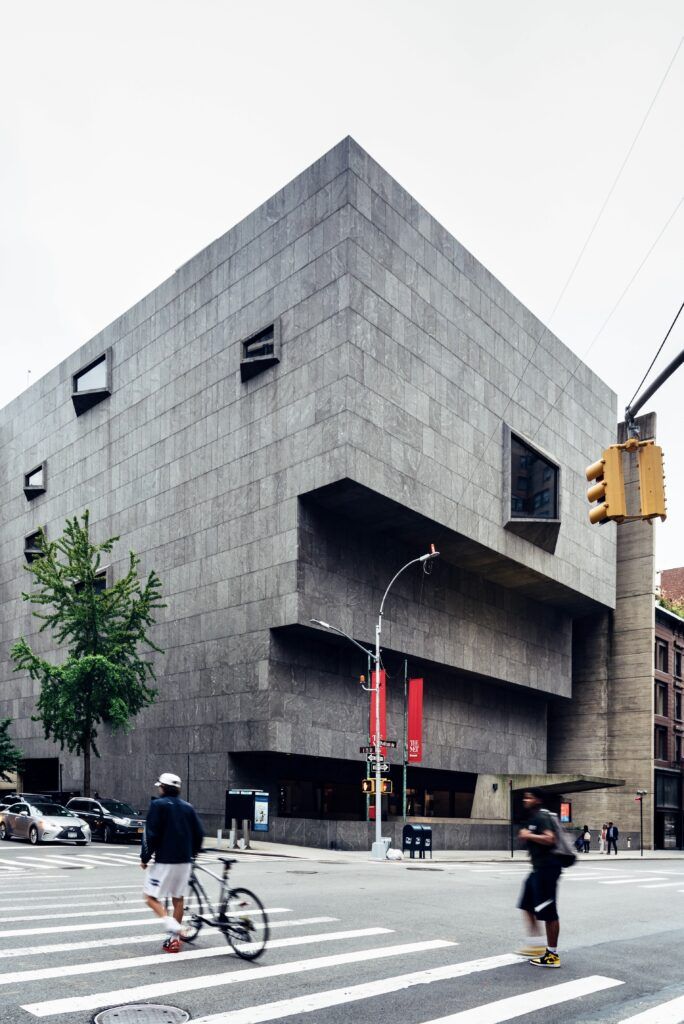
Practical Guide & Tips For Visiting The Frick Collection
Addresses :
- Frick Collection (closed for renovations) : 1 East 70th Street
- Frick Madison : 945 Madison Avenue
Hours : Open Thursday through Saturday from 10:00 am to 6:00 pm.
Adults $22, Seniors $17, Students $12, Youth free. Pay what you wish on Thursday from 4:00 pm to 6:00 pm. Advanced timed entry tickets are strong recommended. Audio guide free.
How Long To Spend At the Frick Collection?
It’s a very manageable size museum. If pressed, you can breeze through the collection in an hour or so. First timers or those studying particular paintings may want to allot 2 hours.
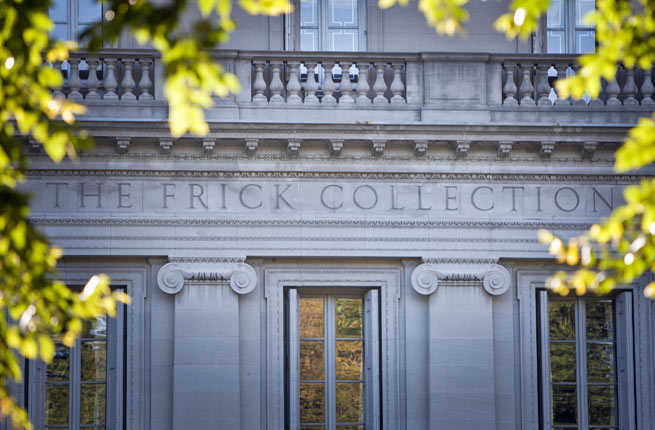
Is the Frick Collection Worth Visiting?
100%!!! Unless you don’t like old masters. Though small, this is an incredibly high quality collection.
Every piece of art there is worth seeing. It’s a tranquil spot to soak in some fantastic art.
I hope you’ve enjoyed my guide to the Frick Collection. You may enjoy these other guides to US art museums:
- 25 best art museums in the United States
- Guide to the National Gallery of Art in Washington DC
- Guide to the Hirshhorn in Washington DC
- Guide to the Phillips Collection in Washington DC
- Guide to the Philadelphia Museum of Art
- Guide to the Getty Center
- Guide to the Rodin Museum
- Gu ide to the Boston Museum of Fine Arts
- Guide to the Isabella Stewart Gardner Museum
If you’d like to visit the Frick Collection, pin it for later.

Leave a Comment Cancel reply
Save my name, email, and website in this browser for the next time I comment.
Last Updated on September 29, 2023 by Leslie Livingston
Have a question?
Our AI assistant is ready to help
Frick Madison: Old Masters and a new dynamic
Words: Charlotte Coates
| 15 min read
The move to a very different venue has allowed visitors to see The Frick Collection in a new light, while Henry Clay Frick House is being renovated
In March 2021, The Frick Collection moved to a temporary home in the iconic Breuer Building on Manhattan’s Upper East Side. This new venue, Frick Madison, allows visitors to continue enjoying the museum ’s stunning collection of Old Master paintings and European fine and decorative arts while its permanent home, the Henry Clay Frick House, is being renovated.
The renovation project will see the mansion’s second floor being opened to the public for the first time. New facilities will be added, and the project will bring improvements to the museum’s accessibility. The building’s infrastructure is also being updated.
With the refurbishments well underway and the collection’s first year at its temporary venue completed, we spoke to Ian Wardropper , the Anna-Maria and Stephen Kellen Director of The Frick Collection, to find out more about the renovation project, and to see what guests can expect from a visit to Frick Madison.
A career in the arts
Wardropper was a long-time fan of The Frick Collection before he took on the role in 2011, as he explains:
“I studied art history in college and did my graduate work in New York City in the 1970s. When I was here as a graduate student, the Metropolitan Museum and the Frick were the two poles of my interests. Later, I ended up working for both institutions.”
Wardropper’s first job was at the Art Institute of Chicago. He worked there for almost 20 years, before moving to the Metropolitan Museum of Art in 2001.
“I was the chairman of the Department of European sculpture and decorative arts at the Met. It’s one of the largest holdings in the world in that field; an enormous department with 60,000 objects, sixty galleries and 10 curators. I had a wonderful time there and then moved to the Frick. It’s a much smaller place, but that is one of the things I like about it.”
“I have always admired the Frick. The trajectory of my career had taken me, having done teaching, scholarship, exhibitions, and acquisitions, to a role where I was more and more in charge of a larger entity and in some ways more of an administrator. I found that I enjoyed trying to help curators bring their projects to fruition. So, there came a moment when I thought becoming a director was the next step. That’s when I ended up coming to the Frick.”
The Frick is a unique collection
Speaking about what makes The Frick Collection unique, he says:
“We’re in a different venue currently. However, in a way that underlines even more what I love about the permanent home of The Frick Collection, which is that it’s the combination of a first-rate collection with a fine house for which the collection was intended. There is this marriage of the two which is greater than the sum of the parts.”
Wardropper says that the small scale of the collection and the spaces is a big part of its appeal:
“My goal is to bring the public back to the kind of pleasure which first sparked my interest in art. That is being able to look closely at a work of art in a setting that didn’t make you feel you have to keep moving because other people were coming in. I want visitors to be able to really take their time enjoying a work of art .
“That is one of the things which I think makes the Frick a special place.”
Becoming Frick Madison
When plans for the renovation of The Frick Collection were approved, the museum was in the position of having to either find a new home or move to a temporary venue.
“The construction project is so all-encompassing that we soon realised the whole collection would have to be moved for safety, and all the staff would have to move out. Initially, we thought we would put everything in storage and that we would close for three years.
“However, I started seeing if there was someplace in New York City, some museum that might have a gallery or two where we could show part of the collection. I ended up coming to the Breuer Building, which was purpose-built in 1966 by Marcel Breuer for the Whitney Museum.”
“The Whitney had moved to a new museum downtown, but it continued to own this uptown building. They first leased it to the Metropolitan Museum for eight years. The Met did some wonderful shows when they were here. However, it proved to be costly for them to run it. So, when I came along looking for a place to see our collection, very quickly, we went into discussions over the Frick taking over the entire building.
“So essentially, we are subleasing from the Met, which is leasing from the Whitney. It is a partnership among the three museums.”
Continuing to show the collection
There were several benefits to this arrangement. Firstly, the timing was perfect. In addition, the Breuer Building is big enough to hold everything in the museum’s collection.
“This allowed us to move the entire collection under one roof, so we can store everything in the same building. That’s very important to any museum when it comes to controlling the security and the climate. There is also room for our entire staff, meaning we can continue our other work, like photography and conservation.”
The most important thing, however, was to be able to continue to show the collection, says Wardropper. This was where the building threw up some challenges:
“We quickly dismissed the idea of trying to show the collection the way we do in the mansion. For instance, with silk wall hangings and huge fireplaces and all of that.
“This brutalist building is almost the antithesis of the mansion; we have to accept the severe walls. But the advantage was that we could build out the galleries however we wanted. So, we engaged Annabelle Selldorf , who is the architect in charge of the renovation of the mansion, and we asked her to design a series of galleries that would match what we wanted to do, showing our collections on three different floors.”
New ways of approaching the pieces
What’s proved to be interesting is that the Frick ended up showing its collection in what, for most museums, is a fairly conventional way, by country and by period.
“But for us, we had never done it that way. Traditionally the Frick, in some ways, is an anti-museum; we don’t show things by period. We show things in the way that a private collector would. This has been a chance for us to review our collection, we have thought about it in new ways.”
“I worried about the traditional audience, that they might not like it. But almost everybody has enjoyed it, because they’re learning new things about the collection, as are we. One of the things I like about that the most is that people are starting to re-appreciate how good our collection is, how good the paintings, the decorative arts and the sculpture are.
“For a frequent visitor to the Frick at the mansion, the paintings can end up seeming part of the décor. But now we have stripped all that away, people can really look at the paintings. And they are reminded that it is a truly great collection.”
Lessons learned from Frick Madison
Will the team take some of these lessons that it has learned at Frick Madison back to its permanent home at the end of this project?
“We haven’t completely finished our plans for how we use the display space in the renovated building ,” says Wardropper. “However, one of the principal changes will be that we are opening up the second floor of the original mansion. Those are the private family rooms; the bedrooms, breakfast room, studies, and spaces like that, which are smaller scale than the rooms downstairs.”
“It will give us about 25% more space to show our collection. That is a big factor because our collection has continued to grow over the years, and more and more things have been going into storage. Once we move back, we’ll be able to bring out the collection more.
“Right now, what we’re thinking through is what objects will work better in the more intimate rooms upstairs. For instance, we ended up putting all our early Italian Renaissance pictures in one small gallery on the third floor here at Frick Madison. They’re very powerful in that small room. There are some rooms on the second floor of the mansion that have roughly those dimensions. So, that’s the kind of thing we’re thinking about doing when we move back up there.
“We’ve also been very fortunate to receive some gifts and private collections, which we’ll be integrating into the new space.”
A revamped mansion
In addition, the renovated Frick Collection building will have, for the first time in its history, a dedicated special exhibition space.
“We had a space before, but it wasn’t designed correctly, it was initially designed as seminar rooms,” explains Wardropper. “For example, it had very low ceilings, which meant that we couldn’t put paintings in those galleries.”
“We’ll also have an education centre which we’ve never had before. We will be making some changes to the library to improve its capacity to deal with digital work. Plus, we’ll have a new auditorium that will be larger and have better acoustics.
“We’ll also be addressing the infrastructure. It’s an opportunity to redo all the skylights and the electrical system, which hasn’t really changed since 1935, to put in whole new heating and air conditioning systems. This is all important for the future preservation of the collection.”
Engaging new visitors
A key area of work for The Frick Collection, like for many other museums, is how to reach and connect with a wider audience .
“One of the issues that we face, more and more pressingly, is trying to do a better job reaching our audience, determining what our audience is and trying to reach a wider audience,” says Wardropper. “How do we reach a younger, more diverse audience that doesn’t think the Frick is for them?”
“It’s not just our problem, I think it’s an issue for museums generally. But it’s a specific concern for us because we are an old master institution in a society that’s paying less and less attention to that aspect of history.
“One of the ways to do it is to have inventive programming that allows people to take an interest in what is on our walls and to try to begin to see themselves there. Our paintings are mostly of white people of European extraction. That’s pretty limiting. But are there ways in which we can talk about what’s not there and why they’re not images of other people.”
Connecting with a wider audience
An example of this kind of programming is Frick Film Project, a collaboration between The Frick Collection and the Ghetto Film School, a Bronx-based independent film organisation.
“For this programme, now in its seventh or eighth year, we work with an organisation that teaches high school kids how to make films. They come into the Frick and over the course of a year they learn about our pictures. Then they make a film inspired by something that’s here.
“A lot of these kids have never been inside of a space like ours. We can reach these kids and show them that old masters had a way of telling a story through a painting and that this might be useful to them when they come to make their own films and tell their stories. That shows how we can come up with creative ways to engage people. It’s one of my favourite programmes that we do.”
“We’ve also hired a new head of education , April Kim Tonin . She’s got a two-year runway to prepare for returning so we’re having intensive conversations about how what audiences we want to reach and how we can reach them.
“I don’t have all the answers yet. But it’s what’s nice about the time that we’re in here is it’s kind of an experimental period; we’re out of our permanent building and we have fewer strictures on us than we might normally. This means that we can try things out, to see what works and what we can move back with us.”
New voices at Frick Madison
Another example of the museum’s efforts to reach a more diverse audience is its recent series, Living Histories: Queer Views and Old Masters .
“That was an idea of the curators, and it was born from the fact that we are, exceptionally in our history, currently lending some of the pictures that Henry Clay Frick bought. When they go out, it occurred to the curators, that we could invite younger contemporary artists to make pictures in response to the missing pictures and the pictures that are still there.
“So, this series has been a pop-up that we have run when something goes out. For instance, we sent a Vermeer to an exhibition in Dresden, and an artist named Salman Toor did a painting called Museum Boys , in response to the Vermeers that were there. We also had a painting by Jenna Gribbon hanging between our two portraits by Holbein , breaking up the pairing of Thomas More and Thomas Cromwell .”
View this post on Instagram A post shared by The Frick Collection (@frickcollection)
“Finally, we’v e sent off our Rembrandt Polish Rider to Poland and a Nigerian-born artist, Toyin Ojih Odutola has created to hang face to face with the Rembrandt Self-Portrait that remains in the same gallery. It’s an interesting kind of dialogue that we’re setting up.
“We also have a series of books called the Frick Diptych series. In this, we invite contemporary artists and writers to put forward a response to an artist. They are small books about a single work of art, and they feature people like William Kentridge, Olafur Eliasson, Alan Hollinghurst , and Hilary Mantel , writing a response to a classic art historical essay.
“That’s been another successful dialogue that we have underway.”
Museums evolve post-COVID
Talking about the main challenges that the museum sector faces going forward, particularly in the wake of the pandemic , Wardropper says:
“I think we’re starting to learn how to live with COVID and it’s clearly had an impact. But it’s not the only factor to consider as we look to the future. There’s been a lot of other factors, both in this country and abroad, and a lot of it has to do with social justice and the very real need to bring greater diversity at every level to institutions like museums.”
“We’ve been relatively fortunate economically, as we’d already downsized before our move to this building. So, we didn’t have kind of the dramatic financial reversal that a lot of other institutions have had during the pandemic. But I think these financial constraints have forced institutions to look at themselves again more closely. The situation is causing us to think about the purpose of museums and what we are doing today.
“There’s certainly more energy put into the audience now. Museums are thinking about what the audience is interested in and how we make the community feel that we are part of them. The solutions are many and I think they vary from institution to institution. A museum should be designed to try to work in whatever the particularities of their community are.”
The power of art
“The Frick is a small, Manhattan-based institution, but we have an internationally recognised collection and programme,” he continues. “So, how can we be both a local museum and an international one?”
“Our weekly video series Cocktails with a Curator was a phenomenal success; we’ve had 1.7 million views of 65 episodes. That came out of nowhere after the pandemic hit.”
“This idea of something very personal and short and with a fun twist, it captured people’s imaginations. It also poses a challenge; how do we keep that going? Should we keep it going? How do we cater to both in-person and digital guests? Can we do both? Can we live stream everything? Or are some things just better in one format or the other?
“These are all just some of the questions which we’re grappling with now. And which a lot of other museums are grappling with too. But mostly I think there’s just a pent-up desire for people to see one another, and to see art. It’s something which I hope we don’t forget as we move past the pandemic, that the arts really can play a role in addressing our social needs.
“We shouldn’t forget the power that art has to do good and to inspire people.”
Looking ahead
Finally, on his hopes for the future of The Frick Collection, Wardropper says:
“The whole team has been working for years to make this renovation a reality. I think that, when it’s finished, the institution will have a renewed sense of its mission.
“I want to keep that balance between being a small intimate space and being one that now has greater resources to do the things that it wants to do. Whether that may be exhibitions or other kinds of public programming.”
“Exhibitions in the field of Old Masters have become rarer and rarer. So, I’m very proud of the fact that the Frick has continued to develop better and better exhibitions. For example, one of our exhibitions, on an 18th-century Italian decorative artist and designer named Luigi Valadier , was named Exhibition of the Year by Apollo magazine in 2019. To be able to mount an exhibition at that level of quality was really rewarding.
“The Frick Collection has created a niche for itself of relatively small exhibitions that are very well focused in a field that is not receiving as much attention these days as it did 20 years ago. With the new facilities, we will be working to continue that, in order to enrich the audience’s knowledge about the permanent collection. I’m proud of what we’ve done in the past and I hope we’ll be able to continue that in the future.”
Top image: Four grand panels of Fragonard’s series The Progress of Love are shown together at Frick Madison in a gallery illuminated by one of Marcel Breuer’s trapezoidal windows. This view shows two of the 1771 – 72 paintings, with two later overdoors visible in the next gallery. Image credit Joe Coscia.
- Museum design
- Museum expansion
- Architecture
- Museum management
Want more articles like this for FREE?
Get the latest attractions industry news direct to your inbox, every day.
- Blooloop daily
- Blooloop weekly
Charlotte Coates
More from this author, exploring the future of museums at cta 2024: sustainability, inclusivity & engagement, history attracts a new crowd: the immersive revolution in museums, 5 best-practice ticketing recommendations for museums & heritage attractions in 2024, immersive art and the ecosystem it lacks, university museums are experiencing a renaissance, a covid inquiry for visitor attractions: are we better prepared now, enjoying this article, search for something, adrenalin rush fec welcomes first surf-inspired brushboarding attraction in the us, nintendo museum reveals new details in video ahead of 2 october opening, neom to use flying electric ships on its waterways, ca sega joypolis to open first flagship outside japan, related content, openai enriches fashion exhibit at the met with bespoke ai chat experience, don't miss out on the best prices for the 2024 blooloop innovation awards, new ai powered customer experience specialist joins blooloop, knowliom partners with backyard to create new cultural group.
Your web browser is out of date. Update your browser for more security, speed and the best experience on this site.
We've detected unusual activity from your computer network
To continue, please click the box below to let us know you're not a robot.
Why did this happen?
Please make sure your browser supports JavaScript and cookies and that you are not blocking them from loading. For more information you can review our Terms of Service and Cookie Policy .
For inquiries related to this message please contact our support team and provide the reference ID below.
Thanks for reading Hyperallergic!
Enter your email below to subscribe to our free newsletters.
Newsletters
- Daily The latest stories every weekday morning
- Weekly Editors' picks of the best stories each week
- Opportunities Monthly list of opportunities for artists, and art workers
View all newsletters | Privacy Policy
An account has already been registered with this email. Please check your inbox for an authentication link to sign in.

Hyperallergic
Sensitive to Art & its Discontents
New York’s Frick Mansion to Reopen in 2024

This is not a paywall
You can keep reading for free! At Hyperallergic , we strive to make art more inclusive, so you’ll never hit a paywall when reading our articles. But, as an independent publication, we rely on readers like you to keep our high-quality coverage free and accessible.
Please consider joining us as a member to support independent journalism.
Already a member? Sign in here.
The Frick Collection has recently announced that it will return to its Manhattan Fifth Avenue mansion late next year. The museum, which houses works from the Renaissance through the early 1900s, relocated to a Marcel Breuer-designed brutalist building on Madison Avenue when renovations began on its original location in March 2021. The Frick’s last day at its temporary location will be March 3, 2024.
The collection’s temporary Upper East Side site formerly housed the Whitney Museum of American Art and the Met Breuer , the Metropolitan Museum of Art’s short-lived institution dedicated to modern and contemporary art. The Whitney used the building from 1966 through 2014, and the Met Breuer exhibited there from 2016 through 2020.
Created by architect and designer Marcel Breuer , the structure is a textbook example of the Brutalist style that dominated mid-century construction. As Brutalism affronted an unfamiliar audience in the 1960s and then fell out of fashion in subsequent decades, the building has been simultaneously mocked and praised .

Among other improvements and additions, the Frick’s renovated building will house a new gallery for special exhibitions, auditorium and education center, updated conservation facilities, and more energy-efficient infrastructure. It will also be accessible for people with disabilities and its second floor will open to the public for the first time.
Gilded Age robber baron Henry Frick built his New York City mansion between 1912 and 1914. It faces Central Park and inhabits the entire stretch between East 70th and East 71st Streets in Manhattan’s Upper East Side. Frick died in 1919 and his collection opened to the public in 1935.
The renovations maintain the original artistic character of the Fifth Avenue mansion — classical motifs, ornate details, and early-20th-century glamor. In its last year at Madison Avenue, the Frick will continue to display its classical collection, but will also showcase a contemporary take on portraiture through an exhibition of works by the late painter Barkley L. Hendricks, known for his personalized depictions of Black Americans.

- Share Copied to clipboard
Elaine Velie
Elaine Velie is a writer from New Hampshire living in Brooklyn. She studied Art History and Russian at Middlebury College and is interested in art's role in history, culture, and politics. More by Elaine Velie
Most Popular
Presenting hyperallergic’s 2024 armory show booth awards, what happened to the armory show.
- Newport Art Museum Left Without a Single Curator After Layoffs
- That Dog You Just Can’t Let Go
- Columbia University’s “Alma Mater” Sculpture Drenched in Red Paint

Market Uncertainty Didn’t Dampen Sales at This Year’s Armory Show
Contemporary artists with large followings beyond the traditional scope of the art world had little trouble unloading their latest works.

Art on Paper Is Still a Wholesome Hub for Fans of the Medium
A miniature book fair, printmaking workshops, and generous price tags more than make up for the more gimmicky aspects of this Manhattan show.

Albuquerque Museum Presents Broken Boxes: A Decade of Art, Action, and Dialogue
A groundbreaking, podcast-inspired exhibition in New Mexico celebrates the artwork and ideas of 23 revolutionary artists of our time.

Two NYC Art Fairs Remind Us It’s Okay to Start Anew
At Clio and Salon Zürcher, I found a drag show, celestial paintings, and welcome spaces for artists to debut new directions.

Is this year’s fair a reflection of a tired, oversaturated, and complacent art market, or am I looking for excitement and discovery where they can no longer be found?

CCS Bard’s Graduate Program in Curatorial Studies Offers a Transformative Education
Students benefit from practical experience within a professional museum setting in New York’s Hudson Valley, as well as training through work placements.

Required Reading
This week: Audre Lorde beyond the famous quotes, women activists in Haiti, the Black Polar explorer you’ve never heard of, a walrus takes a sabbatical, and much more.

“Best Booth”? No, thank you. This year, we honor the real standouts at the fair, from the shiniest artworks to the most Duchampian.

Pioneer Works Opens Applications for 2025 Visual Arts and Music Residents
The Brooklyn nonprofit cultural center welcomes residents working outside the norm who will benefit from its unique facilities and collaborative environment.

In a New Home, the Spring Break Art Show Sticks to Its Roots
For its 13th edition, the fair brings its imaginative spirit to an environment that could certainly use it: a floor of a Tribeca office building.

Visual Treats Abound at Independent 20th Century
Highlights include Lenore Tawney’s fiber work, Selby Warren’s mixed-media paintings, and Julia Isídrez’s ceramics.
We've recently sent you an authentication link. Please, check your inbox!
Sign in with a password below, or sign in using your email .
Get a code sent to your email to sign in, or sign in using a password .
Enter the code you received via email to sign in, or sign in using a password .
Subscribe to our newsletters:
- Podcast Updates on the latest episodes
- Store Updates & special offers from our store
- Film Film reviews and recommendations
- Books Book reviews and recommendations
- Los Angeles Weekly guide to exhibitions in LA
- New York Weekly guide to exhibitions in NYC
Sign in with your email
Lost your password?
Try a different email
Send another code
Sign in with a password
Privacy Policy
Recommended
Frick museum’s renovated nyc mansion to reopen in ‘late 2024’.

The Frick Collection, before long, will head back to its renovated, original location at the Henry Clay Frick House at 1 E. 70th St., at Fifth Avenue.
Since 2021, the acclaimed museum and library has temporarily operated from the Whitney Museum of American Art’s nearby old location, the eye-catching brutalist Breuer Building on 75th Street and Madison Avenue.
On March 3, 2024, though, that temporary location will close in advance of the reopening of its Fifth Avenue home in “late 2024,” according to a recent announcement regarding “its final year” at Frick Madison, as the current location has been dubbed.
“Our residency at Frick Madison has been rewarding and productive, and we look forward to the remaining months of our time at 945 Madison Avenue, as we continue to gain new insights into our collection by seeing it reframed in this unprecedented way,” said Frick director Ian Wardropper in a press release. “We’re delighted about our plans for the coming months while our renovation on East 70th Street continues apace.”
Despite being just five blocks north of the Upper East Side mansion it usually occupies, the Frick Madison has welcomed “new audiences,” Wardropper noted.

Back at the Frick’s first ranch — a 1914 Gilded Age stunner — the space has been expanded to include new second-floor galleries, upgraded visitor amenities and overall accessibility.
As well, the garden will soon be restored.
Before becoming a world-class museum, the property belonged to Henry Clay Frick, who bequeathed both his extensive array of European paintings, sculptures and decorative arts — as well as his glamorous residence — to the public.

Adjacent to the collection is the Frick Art Reference Library, founded by Frick’s daughter, Helen Clay Frick, “and recognized as one of the top resources of its kind in the world,” as the release puts it. In the years it’s taken to complete the renovation, it has not been without its controversies: A number of Frick descendants took major issue with certain elements of the expansion plan. Former mayor Bill de Blasio at one point became embroiled in a conflict of interest issue regarding the fact that a law firm to which he owed $300,000 was also representing the museum, The Post previously reported .

Advertisement

IMAGES
VIDEO
COMMENTS
The Frick Collection was one of the first museums to offer a Virtual Tour in 1998 and due to its popularity we updated and expanded ... The Frick at Your Fingertips Museum and library news straight to your inbox. ... Closed for renovation THE FRICK COLLECTION 1 East 70th Street New York, NY 10021 Closed for renovation FRICK ART RESEARCH LIBRARY ...
The Frick Collection Virtual Tour. ... The Frick at Your Fingertips Museum and library news straight to your inbox. Sign up today! ... Closed for renovation THE FRICK COLLECTION 1 East 70th Street New York, NY 10021 Closed for renovation FRICK ART RESEARCH LIBRARY 10 East 71st Street New York, NY 10021 Permanently closed FRICK MADISON.
Learn some of the secrets of the famous Frick Collection as you stroll by. Discover a charming bookshop tucked into a Fifth Avenue mansion. Uncover one of the last single residence mansion on ...
Visit Museum | The Frick Collection
The tour starts at East 70th St & Fifth Avenue (at the Richard Morris Hunt Memorial), just down the block from the Frick Collection and ends at the Cooper-Hewitt (2 East 91 th Street), the former homes of two protagonists on this tour - Henry Clay Frick (1849-1919) and Andrew Carnegie (1835-1919). Book the Gilded Age Mansions Tour!
The Henry Clay Frick House (also known as the Frick Collection building or 1 East 70th Street) is a mansion and museum building on Fifth Avenue, between 70th and 71st streets, on the Upper East Side of Manhattan in New York City.Designed by Thomas Hastings as the residence of the industrialist Henry Clay Frick, the house contains the Frick Collection museum and the Frick Art Reference Library.
The Fifth Avenue Mansion housing the Frick Collection was built in 1913-1914 for Henry Clay Frick, a successful steel and coke industrialist. A longtime patron of the arts, Frick's collection includes a diverse collection of Western painting, sculpture, and decorative arts. What is most impressive about a visit to the Frick is the opportunity ...
Architects Carrère and Hastings were commissioned to build a villa in New York's Central Park. At the corner of Fifth Avenue and 70th Street, a luxurious villa was built for Henry Clay Frick and his wife Adelaide in 1913/1914 at a cost of $5,000,000. When Frick died in 1919, the residence went into a trust in accordance with his wishes.
Review: The Frick Collection. The Frick Collection. Millionaire industrialist Henry Clay Frick transformed his mansion into a boutique museum focused on Western European art. UPDATE FEBRUARY 2021 ...
The Top 15 Secrets of The Frick Collection in NYC. Henry Clay Frick's house, designed and built between 1912 and 1914, stands majestically on Fifth Avenue. "The Met is admired, but the Frick ...
The Frick Collection is starting a new chapter after 85 gorgeous years at its 1 East 70th Street mansion. Starting March 15, The Frick Madison will be open at 945 Madison Avenue—the former home ...
About. The Frick Collection is your home for art from the Renaissance to the early twentieth century. Founded by Henry Clay Frick and open since 1935, the museum offers visitors intimate encounters with one of the world's foremost collections of European fine and decorative arts. The Frick—whose renovated Fifth Avenue buildings will reopen ...
Reserve a virtual tour of the Frick, led by a museum guide over Zoom. Group Reservations ... THE FRICK COLLECTION 1 East 70th Street New York, NY 10021 Closed for renovation FRICK ART RESEARCH LIBRARY 10 East 71st Street New York, NY 10021 Permanently closed FRICK MADISON. VISIT;
About. The Frick Collection is your home for art from the Renaissance to the early twentieth century. Founded by Henry Clay Frick and open since 1935, the museum offers visitors intimate encounters with one of the world's foremost collections of European fine and decorative arts. The Frick—whose renovated Fifth Avenue buildings will reopen ...
See the sights of New York's Central Park on a unique 2-hour pedicab tour. Your tour guide will show you the sights of Central Park and tell you about its history as you travel at a leisurely pace. There are 5 stops on the 2-hour tour. Each stop is around 5-7 minutes, where you walk to see the sights up close.
September 26, 2023 by Leslie Livingston. In the heart of New York City's Upper East Side lies the Frick Collection — an exceptional fusion of art, history, and luxury. The Frick Collection boasts a splendid array of art and artifacts that span centuries and genres. Visitors can admire an impressive collection of European paintings by ...
The Frick Collection
This new venue, Frick Madison, allows visitors to continue enjoying the museum 's stunning collection of Old Master paintings and European fine and decorative arts while its permanent home, the Henry Clay Frick House, is being renovated. The renovation project will see the mansion's second floor being opened to the public for the first time.
March 4, 2021 at 9:00 AM PST. For the last 100 years, stepping into the exquisitely preserved rooms of the Frick Collection 's mansion on New York's Fifth Avenue was like entering a gilded ...
Gilded Age robber baron Henry Frick built his New York City mansion between 1912 and 1914. It faces Central Park and inhabits the entire stretch between East 70th and East 71st Streets in ...
The art collection will soon move back to its renovated, original location at the Henry Clay Frick House at 1 E. 70th St. on Manhattan's Upper East Side. ... 2020 in New York City. Getty Images.
On November 17, 1914, Henry Clay Frick and his wife moved into their new residence at 1 East 70th Street, now home of The Frick Collection. An online exhibition to mark the 100th anniversary of this event was created by the Archives of The Frick Collection and Frick Art Reference Library, and draws upon documents and photographs to tell the story of the house's planning,
The Frick Residence, New York, 1927. Second Floor Hallway. The Frick Residence, New York, 1927. Helen Clay Frick's Sitting Room. The Frick Residence, New York, 1927. Carriage entrance on 70th Street. The Frick Residence, New York, 1927. Fifth Avenue Garden, taken from the window of the Living Hall.